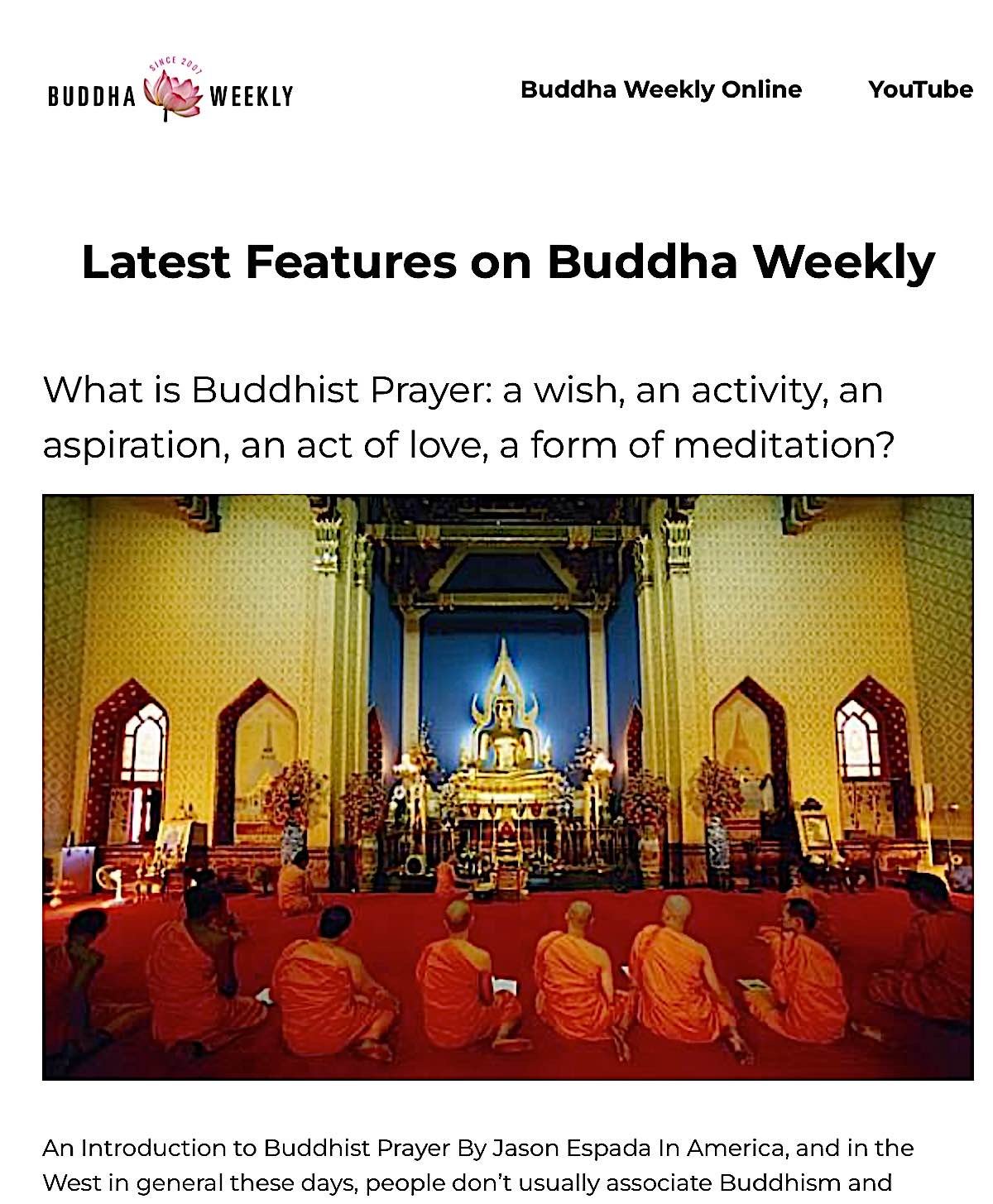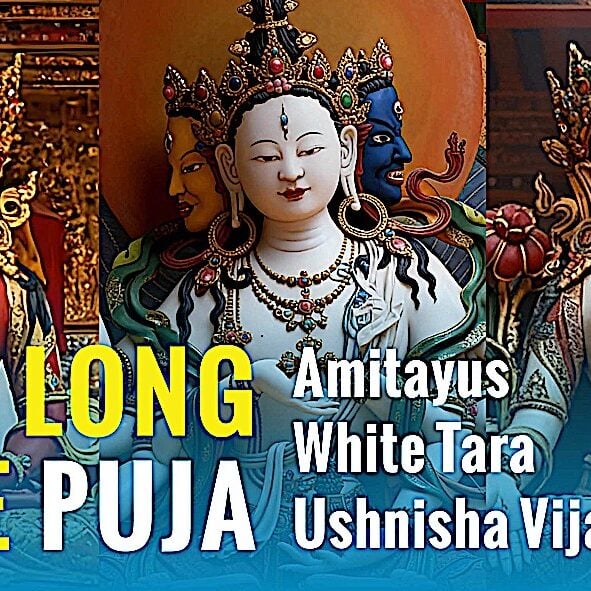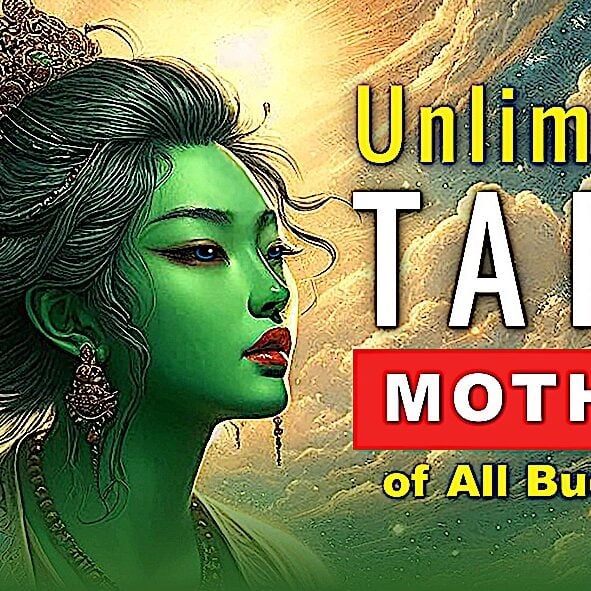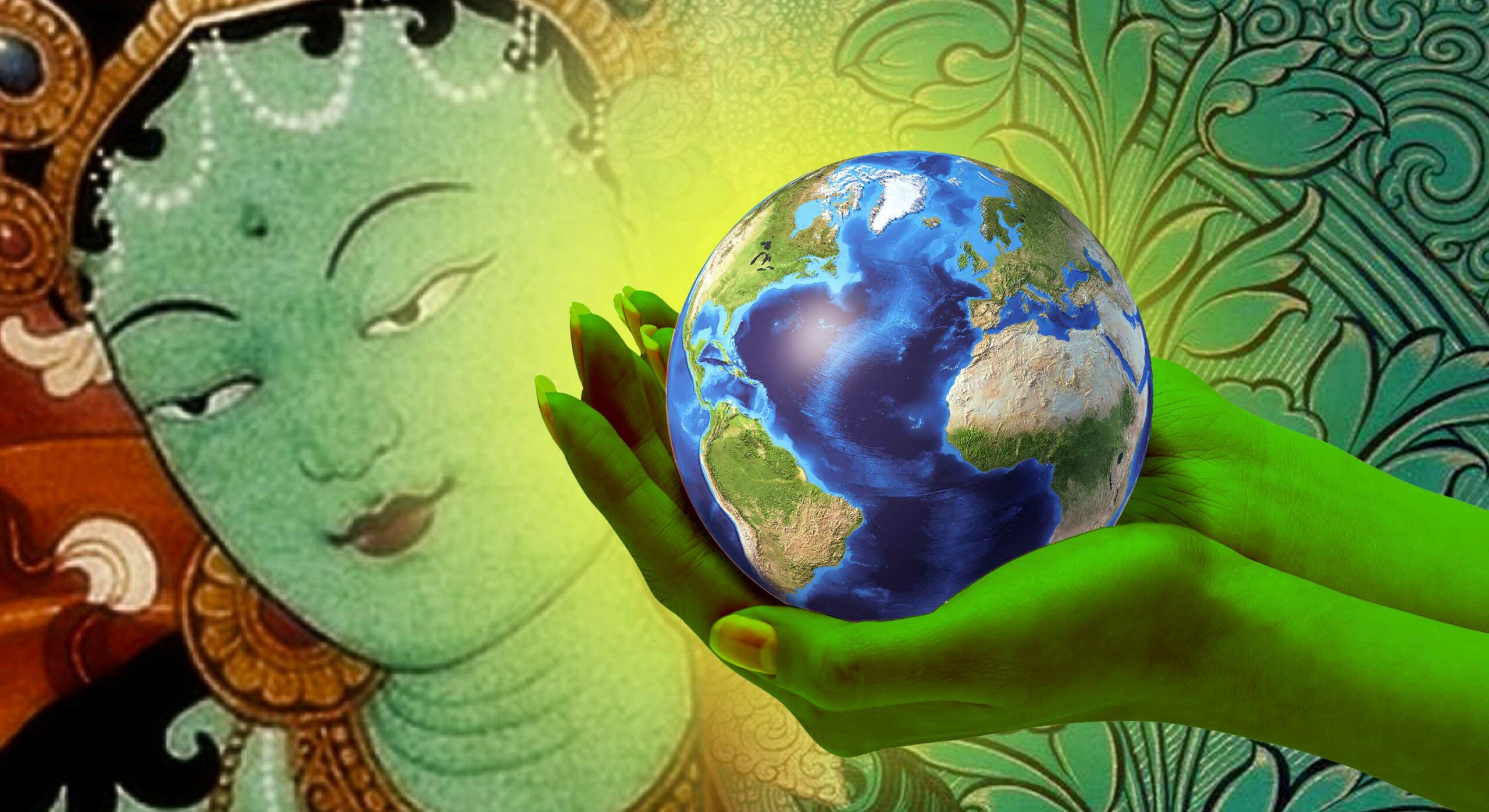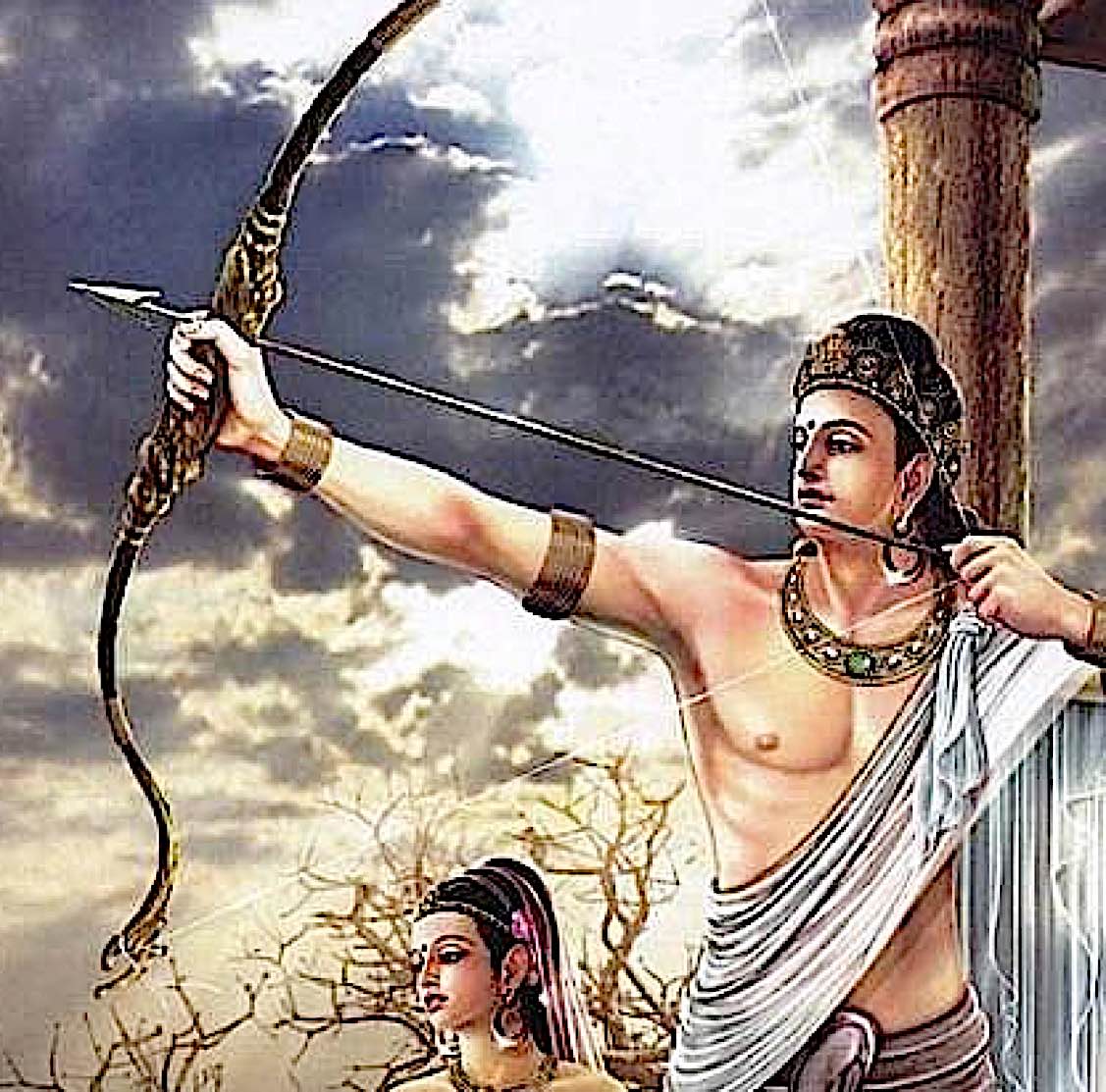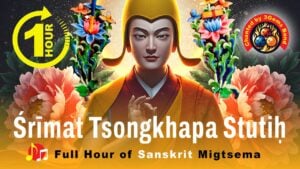21 Taras powerful Dharani Mantras in Sacred Sanskrit as taught by Buddha: how to chant and why it is so effective
The 21 Taras Mantra Dharanis in Sanskrit, as taught by Buddha in the Sanskrit Texts (and translated to Tibetan in the Kangyur), became popularized as the 21 Homages or 21 Praises to Tara.
When chanted in the original Sanskrit, the 21 Praises to Tara are 21 potent and powerful Dharanis (long-form mantras).
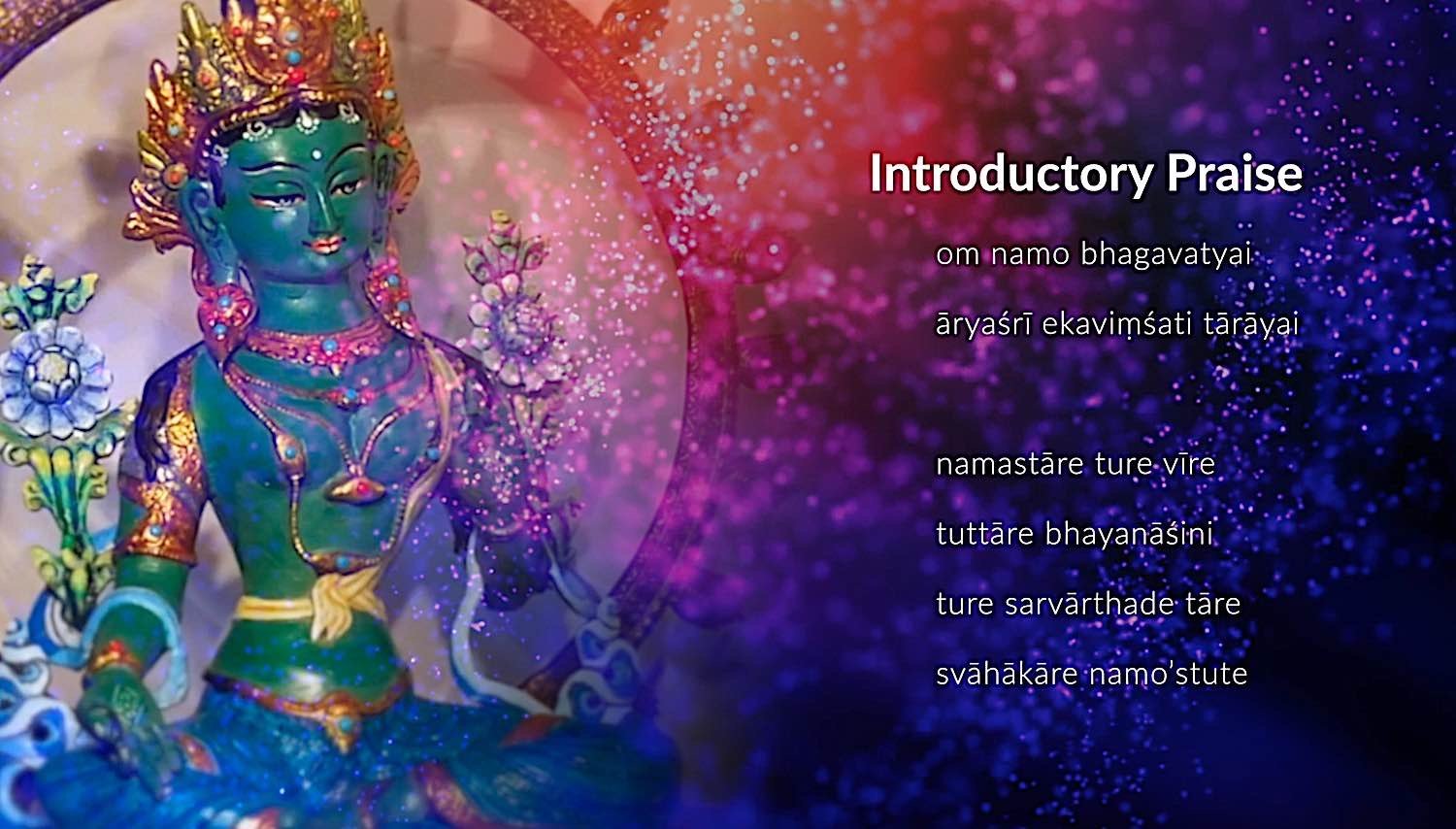
Although popularized as both a Tibetan and English 21 Praise chant, in its Sanskrit Holy syllable form, it is an original Dharani (or series of 21 Dharanis) as taught by the Buddha in Sanskrit Sutra. In its Tibetan or English form (translated in the Kangyur), it loses its sacred vibrational sound and the actual “meaning” (translation) is significantly more simplified. The Dharani, in original Sanskrit, is nuanced and profound.
21 Praises to Tara are Powerful Dharanis
The 21 Praises to Tara are famous for blessing activity, protection, healing, long-life practice, and wish-fulfillment —but these stated benefits are actually in reference to the original Sanskrit sounds.
Hrishikesh Sonar correctly pronounces the Sanskrit Dharanis for us in a beautiful chant, with captions for chant-along:
NOTE: the principle of Sanskrit Dharani applies to all lineages of 21 Taras: Surya Gupta lineage, Atisha lineage or Nyingma lineages. Although the video below, which is correct Sanskrit pronunciation, visualizes with the ancient Surya Gupta lineage (paintings by Niels Petersen) the same Dharanis and pronunciation are correct for all visualization systems. In future, we’ll produce separate videos for these lineages.
Mantras and Dharanis should not be translated
In the same way a mantra, such as Om Mani Padme Hum loses most nuance and “potency” if translated for chanting to English — literally this translates, according to scholars as praise to the jewel in the lotus — in its Sanskrit form it is empowered by Sanskrit’s sacred mother syllables. In other languages, a mantra or Dharani simply becomes more of a “chanted prayer or praise” or hymn.
Likewise, the powerful mantra of Tara, in sacred sound form Om Tare Tuttare Ture Svaha, becomes in English: I prostrate to Tara the liberator, mother of all the victorious ones. While this is a lovely praise, it no longer has the essence of sacred syllable and nuanced meaning.
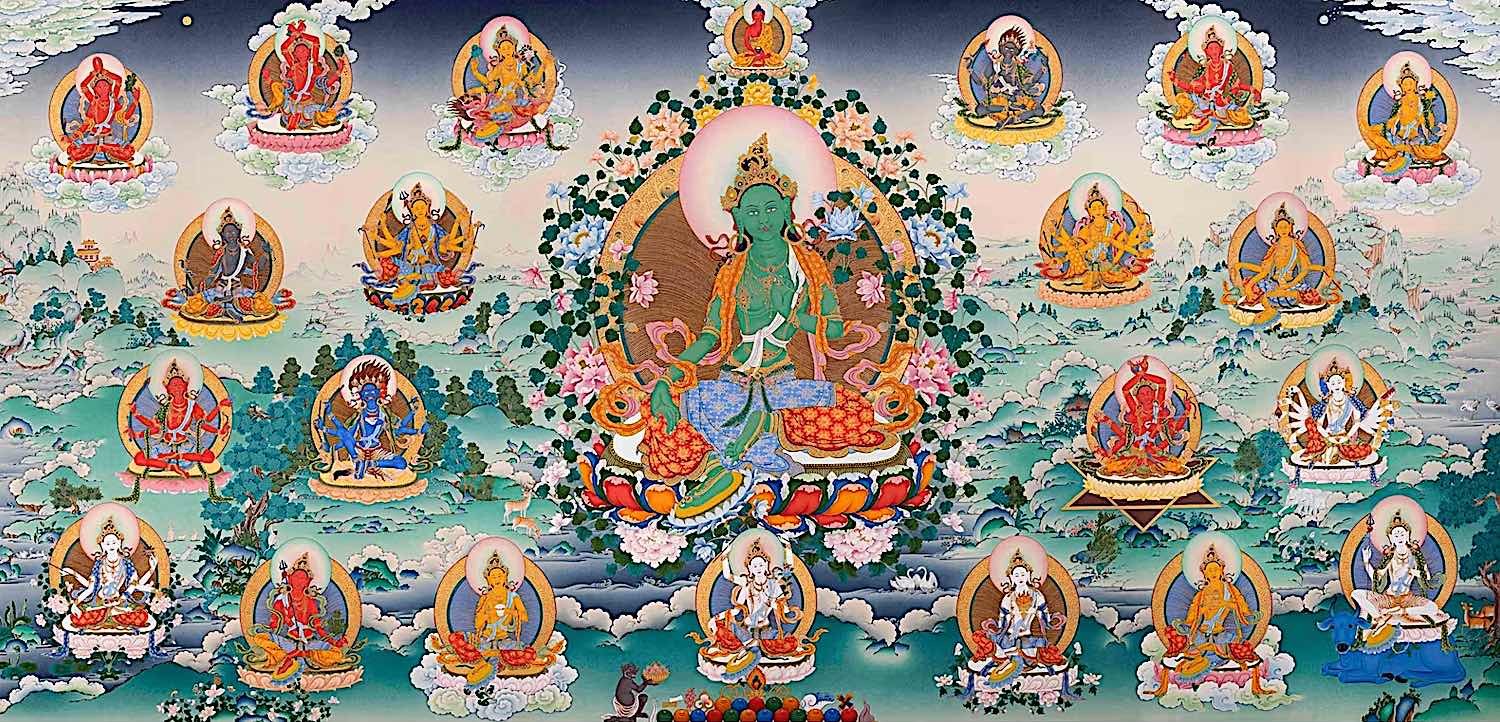
Enlightened Deities will respond to anyone, regardless of language. The question of translation and language relates to “mantras” and Dharanis both.
For example, Om is a short form of AUM, which are the seed syllables of Body, Speech and Mind. As such, it represents the body, speech, and mind of all the Buddhas — in that simple Sanskrit Syllable Om. So, to do justice to a translation, we’d have to translate Om not as “I prostrate” but instead as “I prostrate to the body, speech and mind of Tara, the liberator.” Then, when you start to translate Tare (the next two syllables of Tara’s mantra), we find it has many meanings. Tare can mean “freeing from samsara,” but it can also mean “liberation from suffering” and “protection from fear” and about twelve other wonderful nuances, all in those two little syllables.
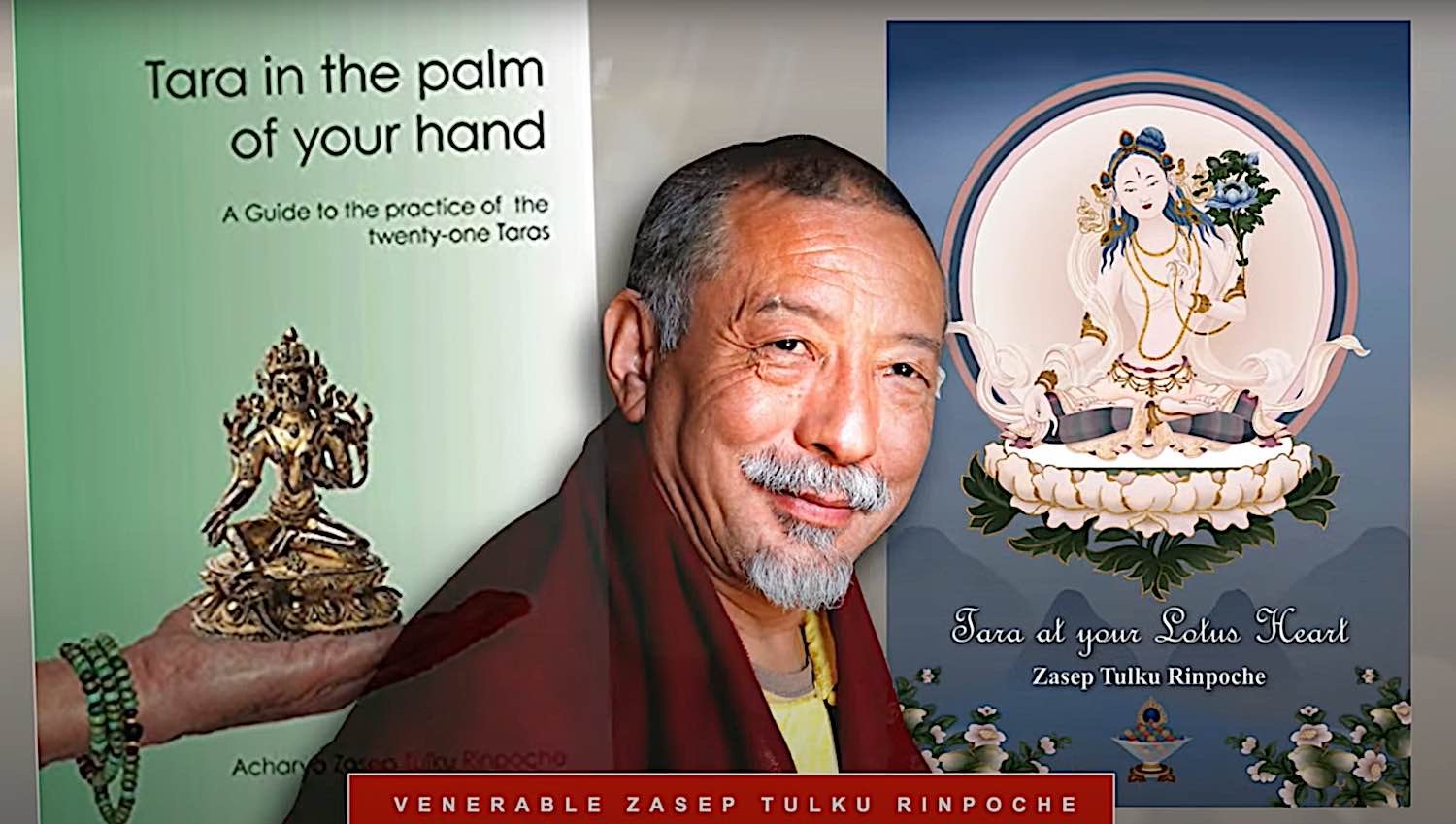
Mantras, like Poetry, are difficult to translate without losing something. Dharanis are even more challenging (the 21 Praises are actually 21 Dharanis.) In English, we call it “Praise,” but Dharani means much more than praise. It means “essence” and “sound essence” and “empowered vibration” and “homage,” and another thirty or forty things. Any one of them alone, as a single English word, is misleading. This is why teachers often recommend students chant in Sanskrit and their native language both. (Sanskrit and English or Sanskrit and Tibetan, and so on.)
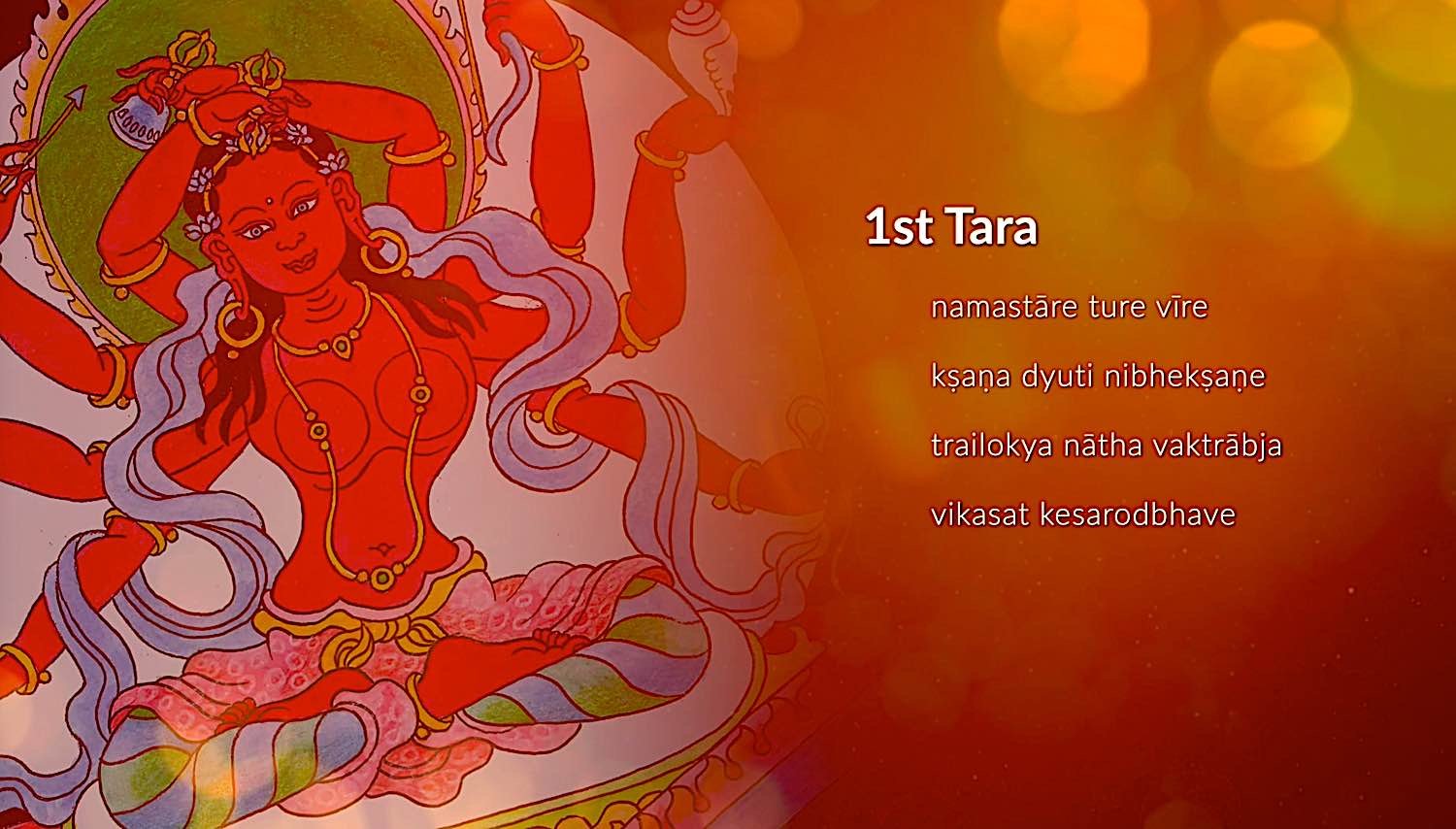
The benefits of the Dharanis are fully stated in the final verses of the sacred texts, which outline the specific benefits to devout practitioners. The benefits, however, are for the Dharanis as transmitted by Buddha, in the original Sanskrit.
The benefits (if you translate them to English) are stated in the text as (here translated to English for clarity):
“Whoever is endowed with devotion for the goddess and recites this with supreme faith,
Remembering it at dawn upon waking and in the evenings,
Will be granted all fearlessness, will perfectly pacify all negativities,
And will eliminate all unfortunate migrations.
The multitudes of conquerors will quickly grant initiation:
Thus, endowed with this greatness, one will eventually reach the state of a buddha.
If affected by the most terrible poison,
Whether ingested, drunk, or from a living being,
Just by remembering, will one be thoroughly cleansed.
If this prayer is recited two, three, or seven times,
It will alleviate all the sufferings of torments
They are caused by spirits, fevers, and poisons, and by other beings as well.
If you wish for a child, you will get a child;
If you want to for wealth, you will receive wealth.
All your wishes will be fulfilled
And all obstacles pacified.
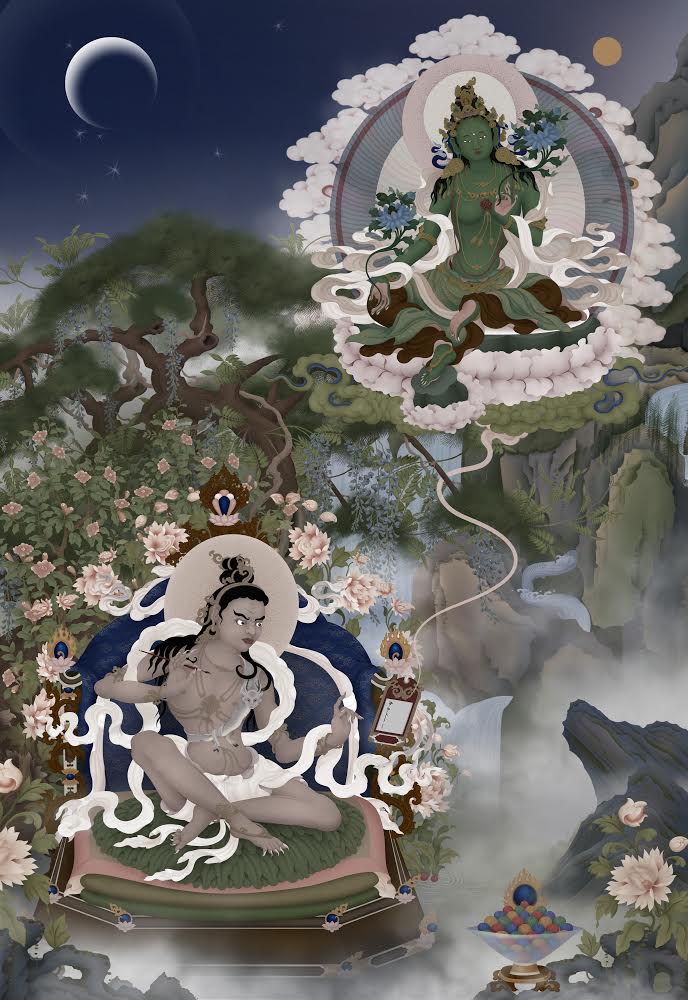
Why 21 Dharanis?
Tara, the Mother of the Buddhas, emanates in countless forms to help suffering beings in our troubled world. Each of these forms specializes in one of these Enlightened activities: the various White Taras for peaceful activity, the Red Taras for magnetizing and enchanting, the Yellow Taras for auspiciousness and wish-fulfillment, and the Black Taras for wrathful power to overcome evil or negative forces and obstacles.
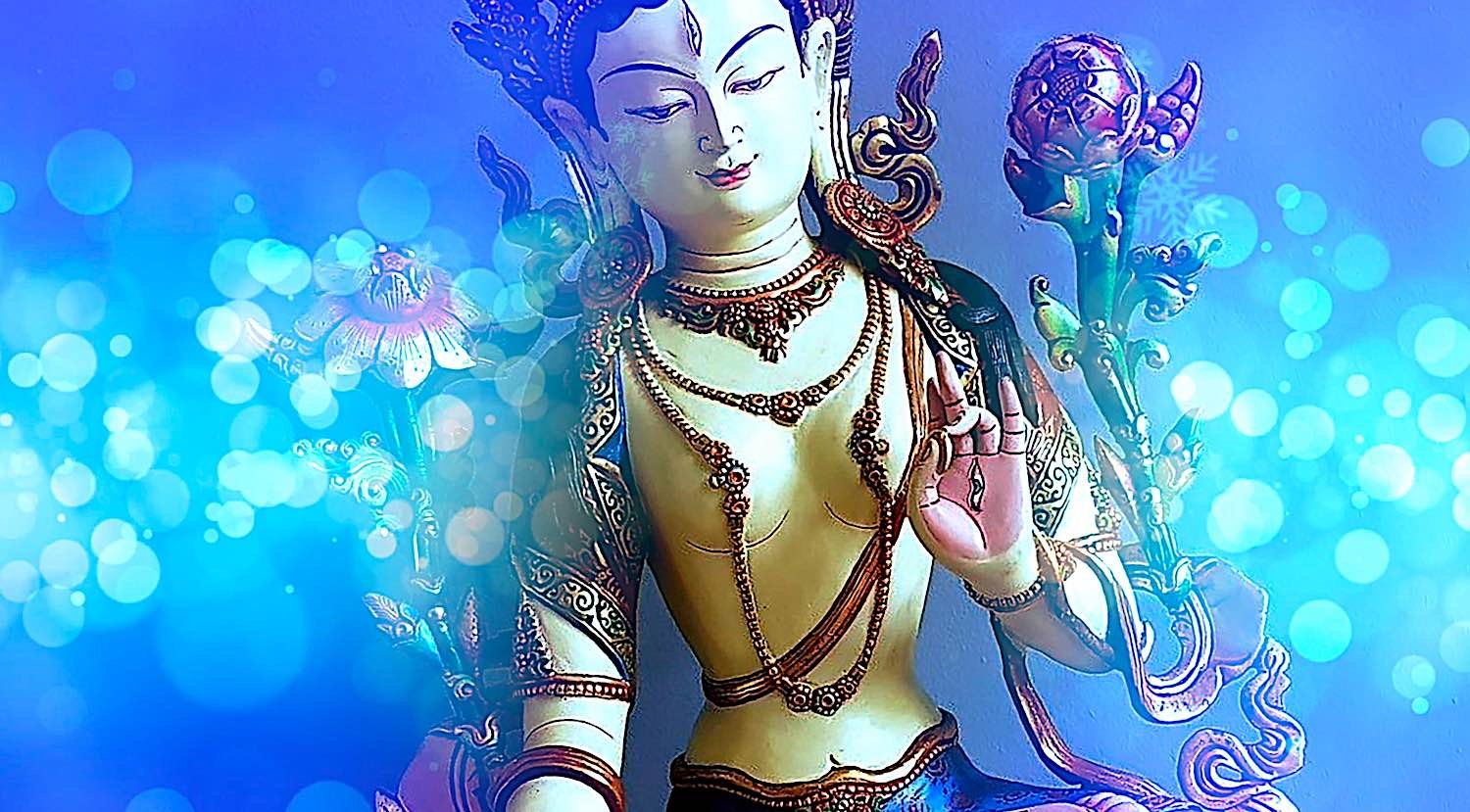
Chanting Tara’s Praises daily — especially in the original Sanskrit — is a practice recommended by countless Buddhist teachers. Shakyamuni Buddha taught the 21 Praises originally in Sacred Sanskrit. Chanting the praise with the original Sanskrit vowels of Buddha is important as an empowering method, energizing the sounds with mantra and seed syllable vibrations.
NOTE: In the featured video, Hrishikesh Sonar demonstrates the correct Sanskrit pronunciation, here beautifully chanted. Many people do not chant musically — but the pronunciation is the same. Note: in the English lettered Sanskrit below, any time you see an s or a c with a special accent — such as ś or ṣ — it is usually pronounced soft-style as is “sh” or “ch.”
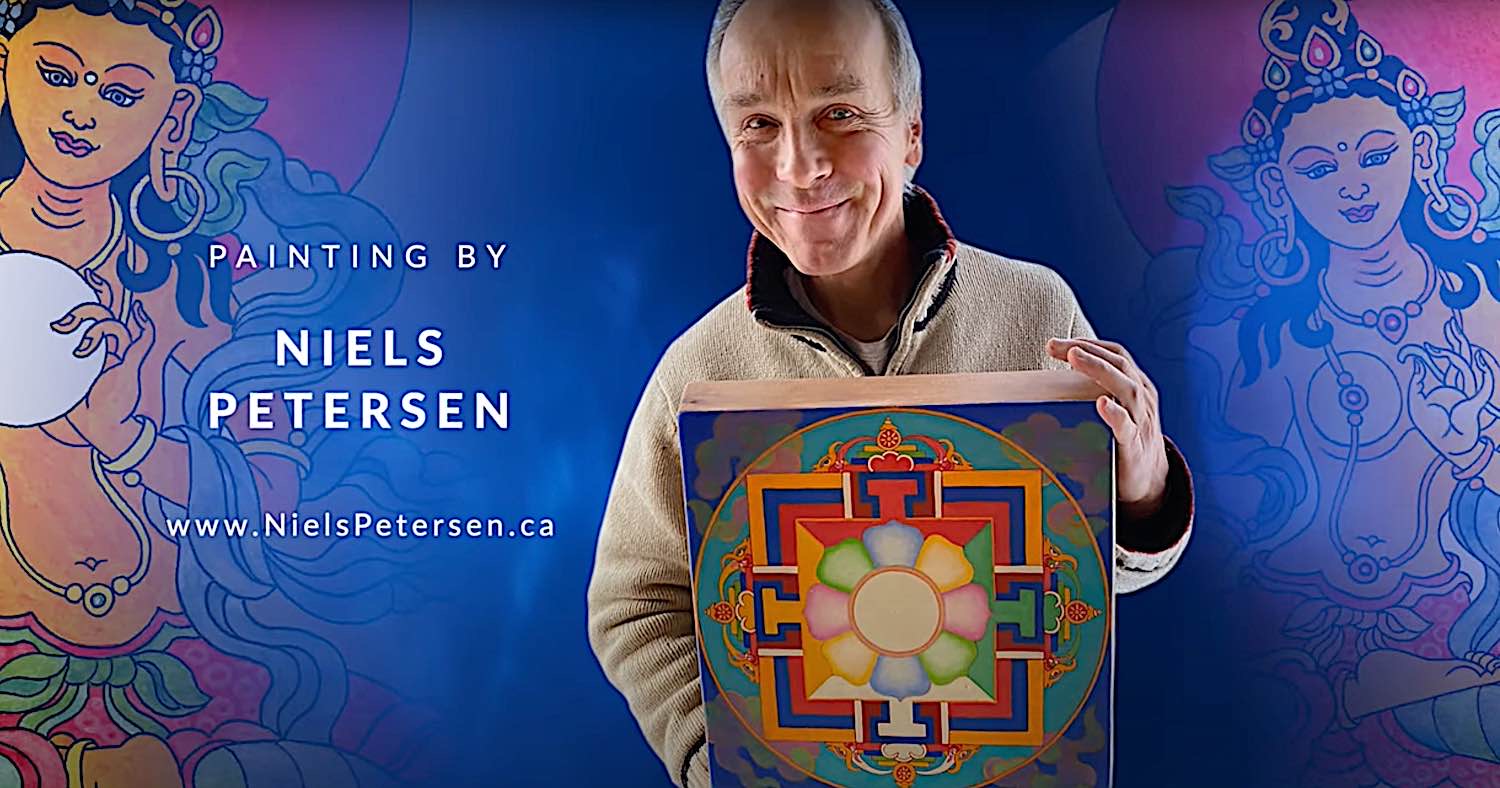
Bring the blessings and protection of Mother Tara into your life with this sacred and profound praise sung in the Mother language Sanskrit. Visualize the 21 Taras — here presented through the art of Niels Petersen, according to the ancient lineage of Surya Gupta, as taught in the books Tara in the Palm of Your Hand, and Tara at Your Lotus Heart by Venerable Zasep Rinpoche.
To learn more about the 21 Taras we strongly recommend Tara in the Palm of Your Hand. Even more in-depth is the new book from Venerable Zasep Rinpoche, Tara at Your Lotus Heart.
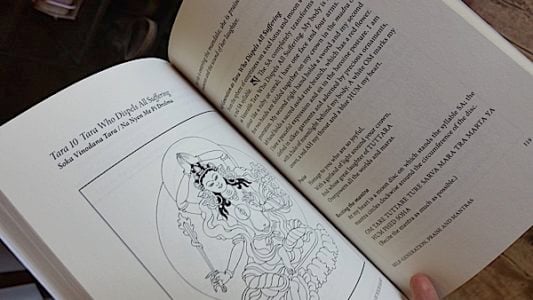
Sanskrit Dharani of the 21 Taras
With descriptions of the names, colors and powers of each Tara according to the book Tara in the Palm of Your Hand (found on Amazon here>>)
Although the tradition is that you chant the entire 21 Dharanis plus the introductory Dharani daily or three times daily, if you have a specific issue or problem — if you need Tara’s help with a specific activity — you can look at the “Power or Rite” description below. The Color also indicates the type of activity
- Red: Power and magnetizing or enchanting
- White: Pacifying or calming and long-life
- Blue or Black: Wrathful power to turn back obstacles, negative karmas, evil forces
- Yellow: Auspiciousness and attracting good fortune.
- Green: Combines all the colors and activities.
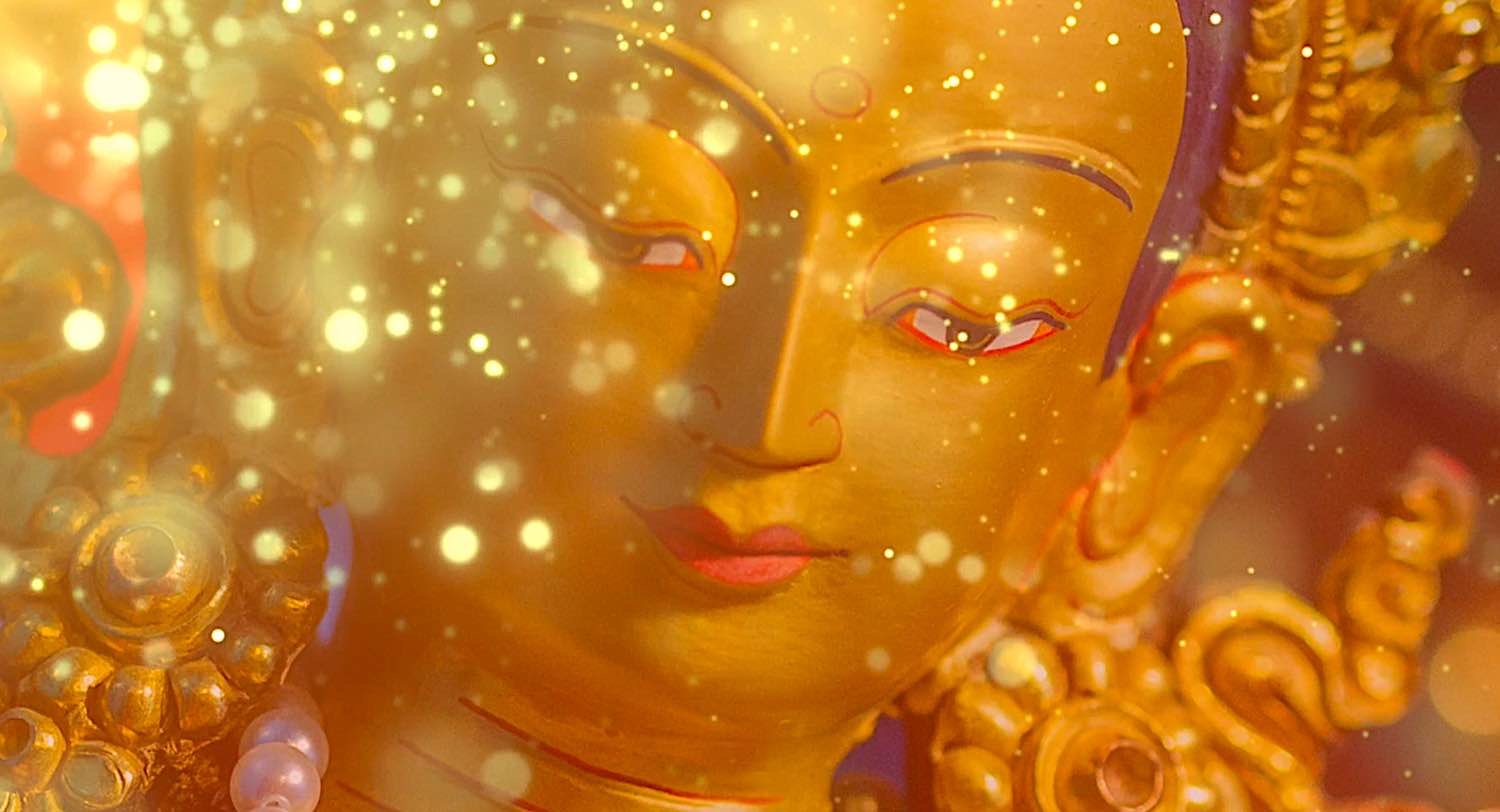
Introductory Dharani
om namo bhagavatyai āryaśrī ekaviṃśati tārāyai
namastāre ture vīre
tuttāre bhayanāśini
ture sarvārthade tāre
svāhākāre namo’stute

1st Tara Dharani
Sanskrit: Pravita Tara
Tibetan: Rabtupa We Drolma
English: Heroic Red Tara
- Power or Rite: turning back the power of others.
- Seed syllable OM
- Colour: red
- Arms: 8
- Peaceful or wrathful: peaceful
namas tāre ture vīre
kṣaṇa dyuti nibhekṣaṇe
trailokya nātha vaktrābja
vikasat kesarodbhave
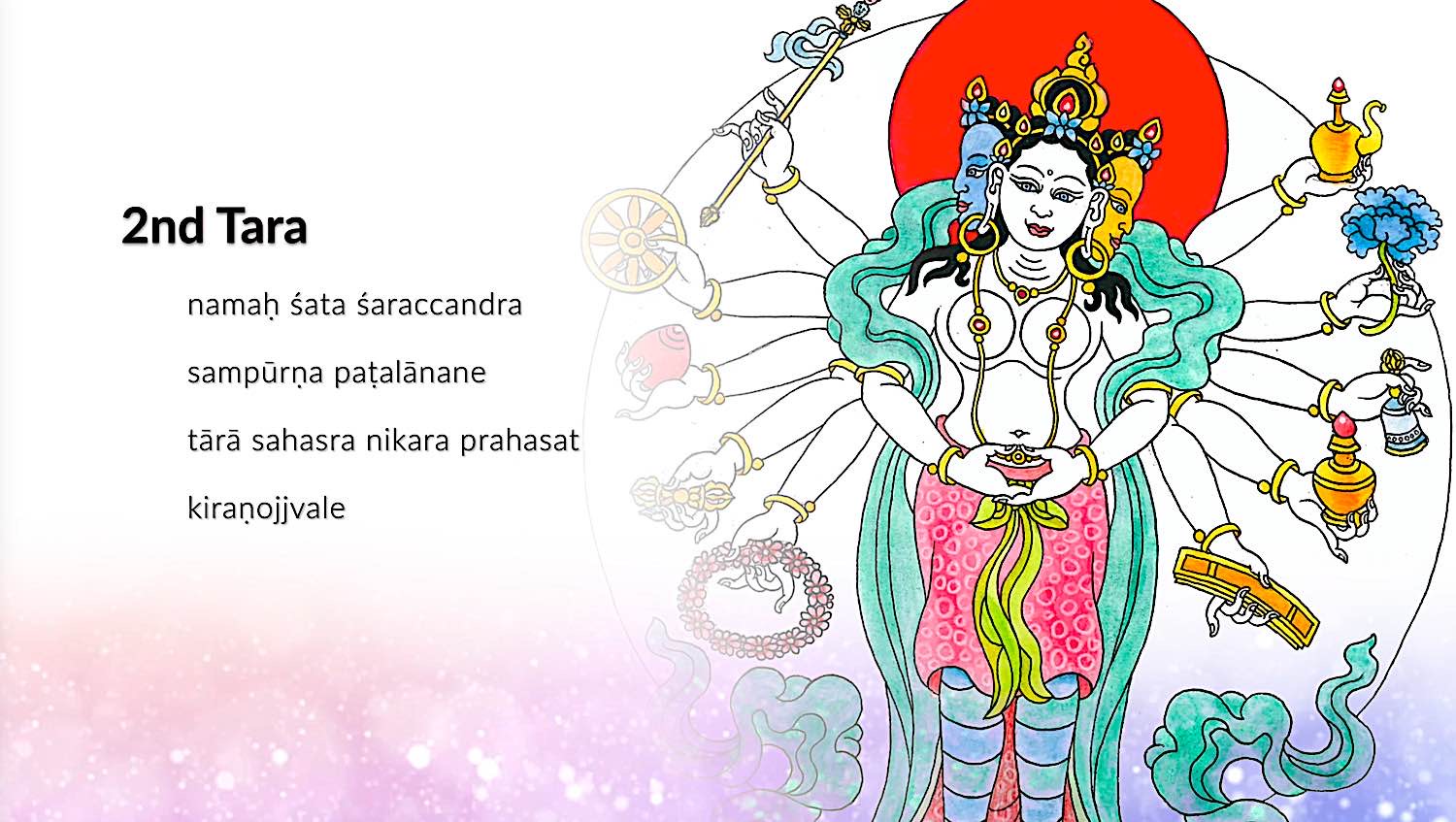
2nd Tara Dharani
Sanskrit: Chandra Kanti Tara
Tibetan: Karmo a Dang Ge Drolma
English: Moonlight White Tara
- Power or Rite: calming infectious disease.
- Seed syllable TAM
- Colour: white
- Number of arms: twelve
- Peaceful or wrathful: peaceful
namaḥ śata śaraccandra
sampūrṇa paṭalānane
tārā sahasra nikara prahasat
kiraṇojjvale
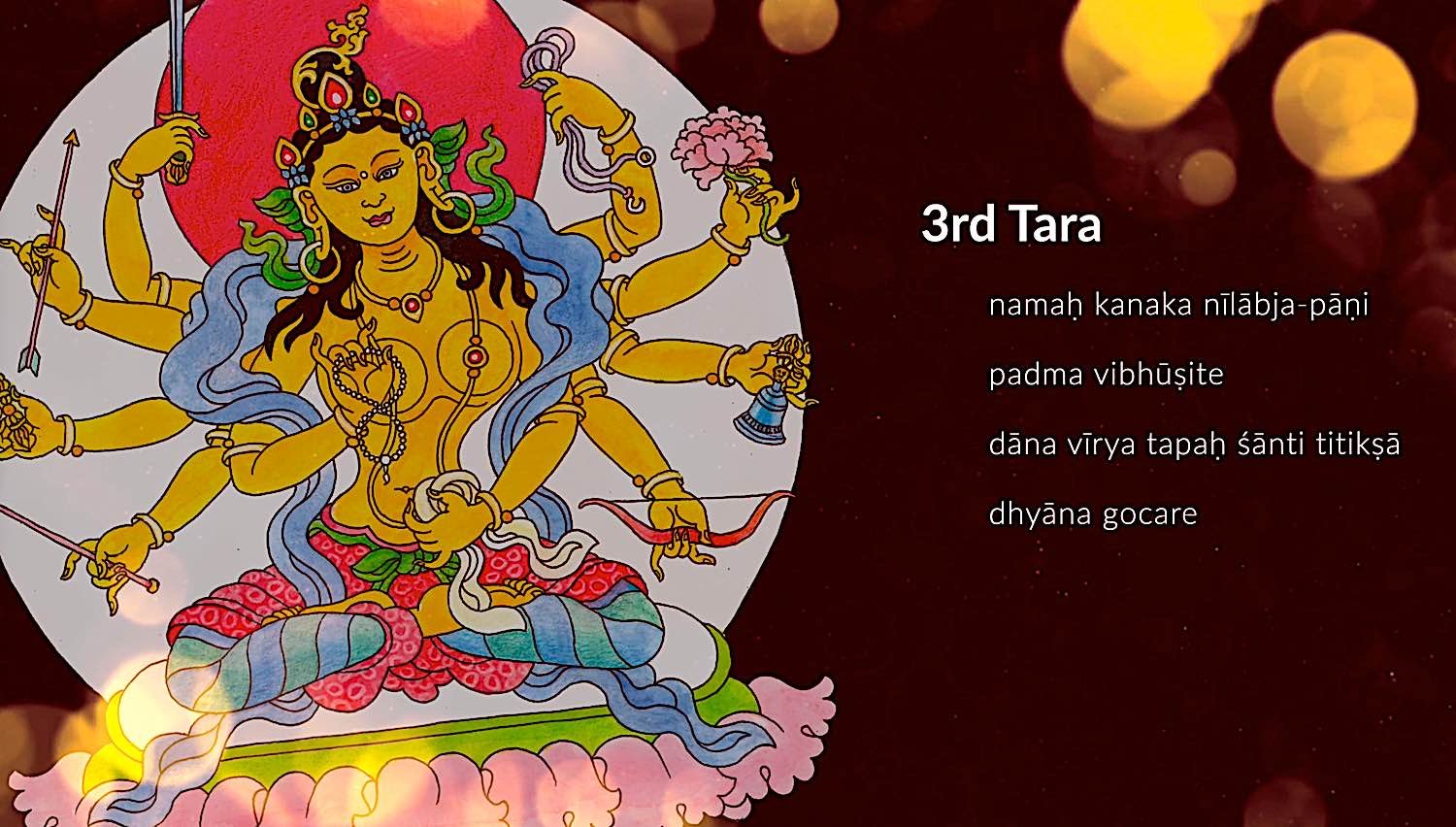
3rd Tara Dharani
Sanskrit: Kanaka Vana Tara
Tibetan: Ser Mo Serdok Chen Ge Drolma
English: Golden Color Tara
- Power or Rite: calming infectious disease.
- Seed syllable TAM
- Colour: white
- Number of arms: twelve
- Peaceful or wrathful: peaceful
namaḥ kanaka nīlābja-pāṇi
padma vibhūṣite
dāna vīrya tapaḥ śānti titikṣā
dhyāna gocare
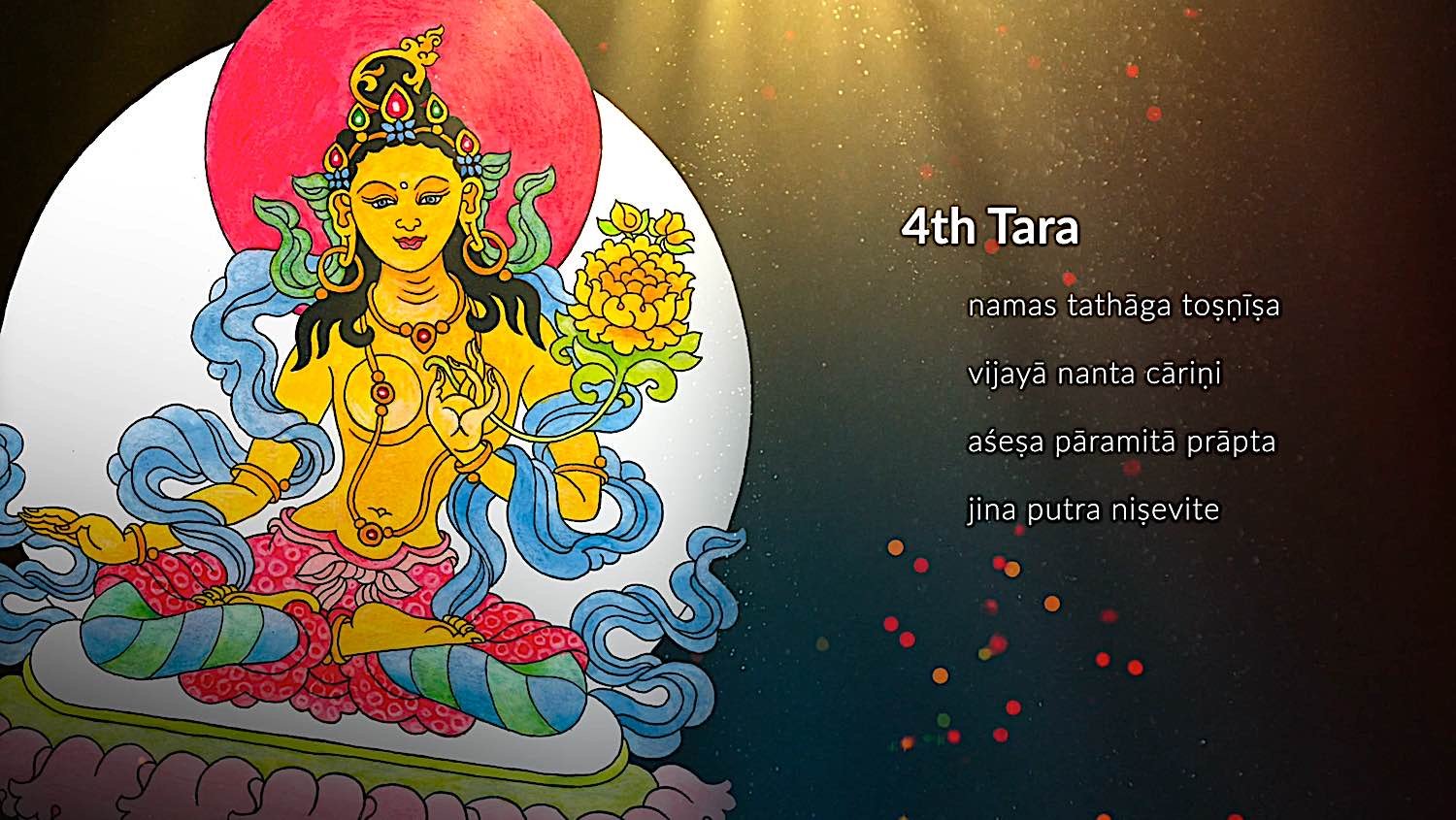
4th Tara Dharani
Sanskrit: Usnisa Vijaya Tara
Tibetan: Tsug Tor Nam Pal Gyal We Drolma
English: Golden Tara of Crown Victorious
- Power or Rite: neutralizing lethal poisons.
- Seed syllable TUTA
- Colour: golden
- Number of arms: four
- Peaceful or wrathful: peaceful
namastathāgatoṣṇīṣa
vijayānantacāriṇi
aśeṣapāramitāprāpta
jinaputraniṣevite

5th Tara Dharani
Sanskrit: Hum Svara Nadini Tara
Tibetan: HUM Dra Dolpi Drolma
English: Tara Proclaiming the Sound of HUM
- Power or Rite: subjugating.
- Seed syllable TA
- Colour: yellow
- Number of arms: two
- Peaceful or wrathful: peaceful
namastuttāra huṅkāra
pūritāśā digantare
saptaloka kramākrānt niḥśeṣ
ākarṣaṇa kṣame
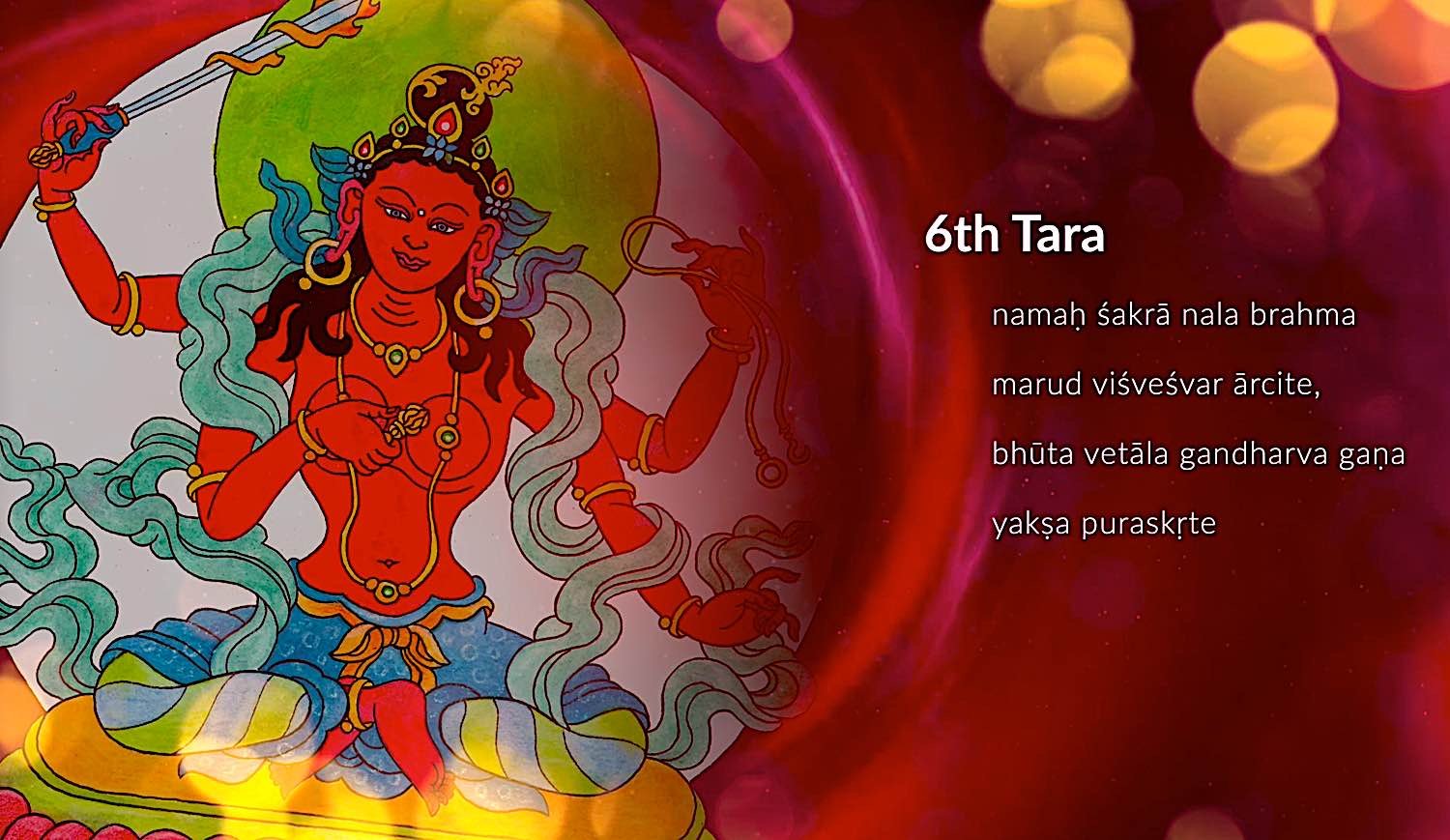
6th Tara Dharani
Sanskrit: Trai Lokya Vijaya Tara
Tibetan: Jig Ten Sum Lay Nam Par Gyal We Drolma
English: Tara Victorious over the Three Levels of the World
- Power or Rite: purification of all obscurations and negativities.
- Seed syllable RE
- Colour: ruby red
- Number of arms: four
- Peaceful or wrathful: peaceful
namah śakrā nala brahma
marud viśveśvar ārcite,
bhūta vetāla gandharva gaṇa
yakṣa puraskṛte

7th Tara Dharani
Sanskrit: Vadi Pramardani Tara
Tibetan: Golwa Jompi Drolma
English: Tara Who Crushes Adversaries
- Power or Rite: Destroyer of adversaries (adversaries means obstacles and obscurations).
- Seed syllable TU
- Colour: ruby black
- Number of arms: four
- Peaceful or wrathful: wrathful
namas triḍiti phaṭkāra
parayantra pramardini
pratyālīḍha padanyāse
śikhi jvālā kulojjvale

8th Tara Dharani
Sanskrit: Mara Sudana Vasitottama Da Tara
Tibetan: Wang Chug Terwe Drolma
English: Tara Who Gives Supreme Spiritual Power
- Power or Rite: completion stage practices; destroyer of Maras (demons) and the two obstructions
- Seed syllable TU
- Colour: ruby black
- Number of arms: four
- Peaceful or wrathful: wrathful
namasture mahāghore
māra vīra vināśini
bhṛkuṭī kṛta vaktrābja
sarva śatru niṣūdini
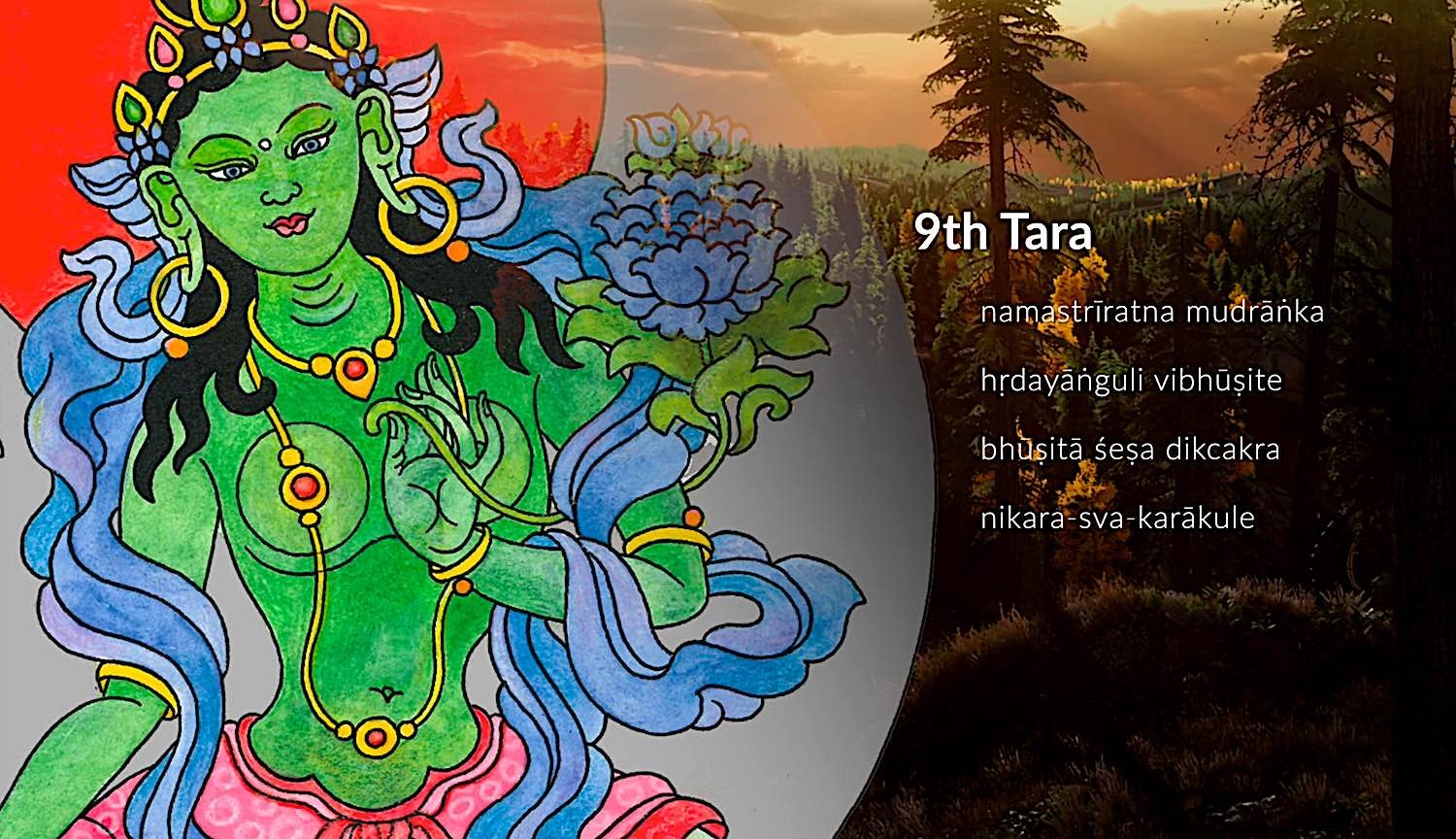
9th Tara Dharani
Sanskrit: Khadiravana Tara
Tibetan: Seng Ding Nag Che Drolma
English: Tara of the Khadira Fragrant Forest (Principle Green Tara)
- Power or Rite: Principle Green Tara: all activities
- Seed syllable TAM
- Colour: green
- Number of arms: 2
- Peaceful or wrathful: peaceful
namastrīratna mudrāṅka
hṛdayāṅguli vibhūṣite
bhūṣitā śeṣa dikcakra
nikara-sva-karākule
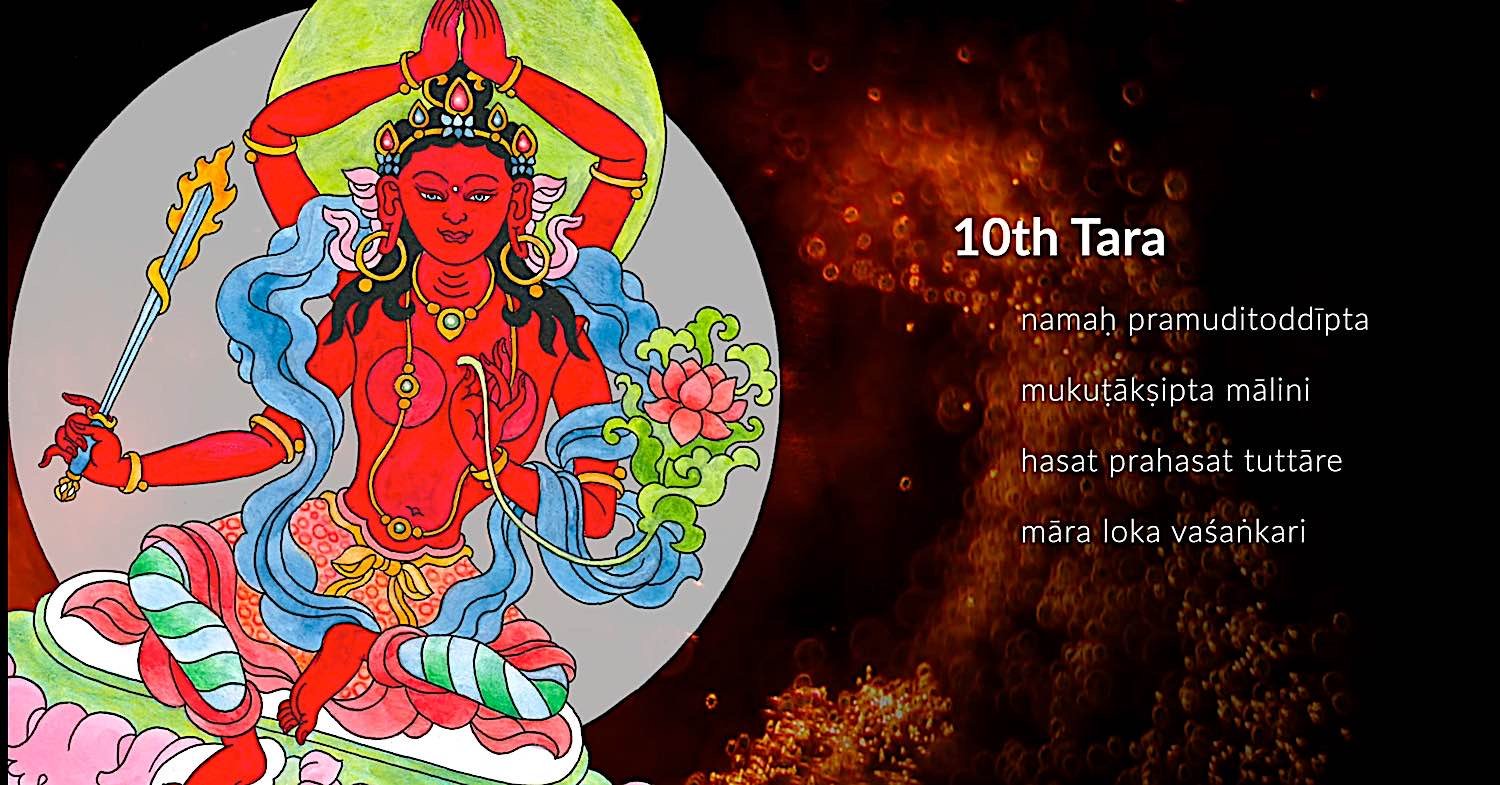
10th Tara Dharani
Sanskrit: Soka Vinodana Tara
Tibetan: Na Nyen Me Pi Drolma
English: Tara Who Dispels All Suffering
- Power or Rite: Her rite is entering the mandala
- Seed syllable SA
- Colour: red
- Number of arms: 4
- Peaceful or wrathful: peaceful
namaḥ pramuditoddīpta
mukuṭākṣipta mālini
hasat prahasat tuttāre
māra loka vaśaṅkari

11th Tara Dharani
Sanskrit: Jag Vasi Vipan Nirbarhana Tara
Tibetan: Dro Wa Gug Pa Am Pungpa Sel We Drolma
English: Tara Who Summons All Beings and Dispels Misfortune
- Power or Rite: Increasing enjoyments and accomplishing activities through the ten guardians
- Seed syllable HA
- Colour: black
- Number of arms: 2
- Peaceful or wrathful: wrathful
namaḥ samasta bhūpāla
patal ākarṣaṇa kṣame
calada bhṛkuṭi hūṃkāra
sarvāpada vimocini
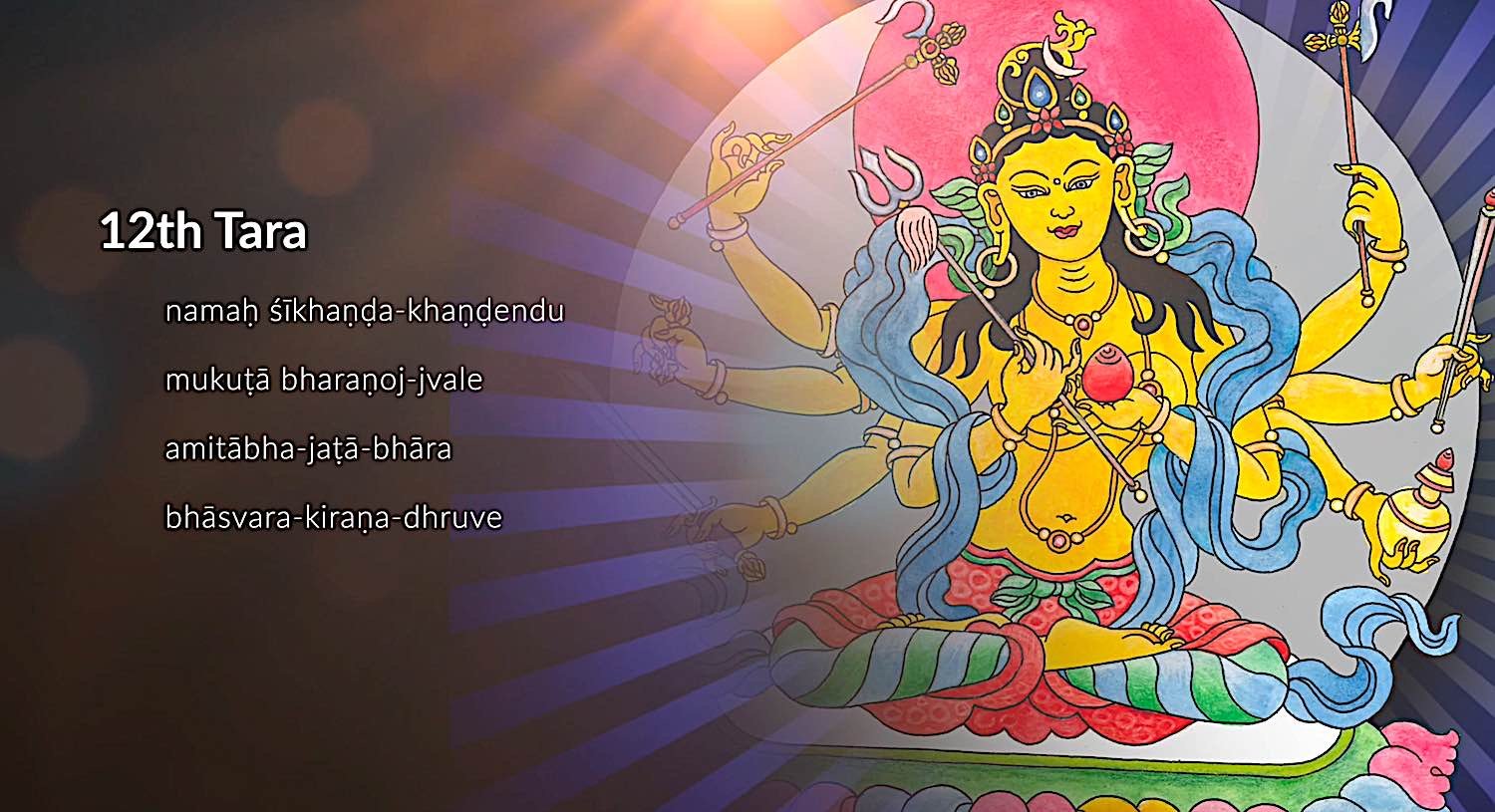
12th Tara Dharani
Sanskrit: Kalyana Da Tara or Manga Laloka Tara
Tibetan: Tashi Nang We Drolma
English: Tara Who Grants Prosperity and Brings about Auspicious Circumstances
- Power or Rite: Her rite is the fire offering
- Seed syllable AH
- Colour: yellow
- Number of arms: 8
- Peaceful or wrathful: peaceful
namaḥ śīkhaṇḍa-khaṇḍendu
mukuṭā bharaṇoj-jvale
amitābha-jaṭā-bhāra
bhāsvara-kiraṇa-dhruve
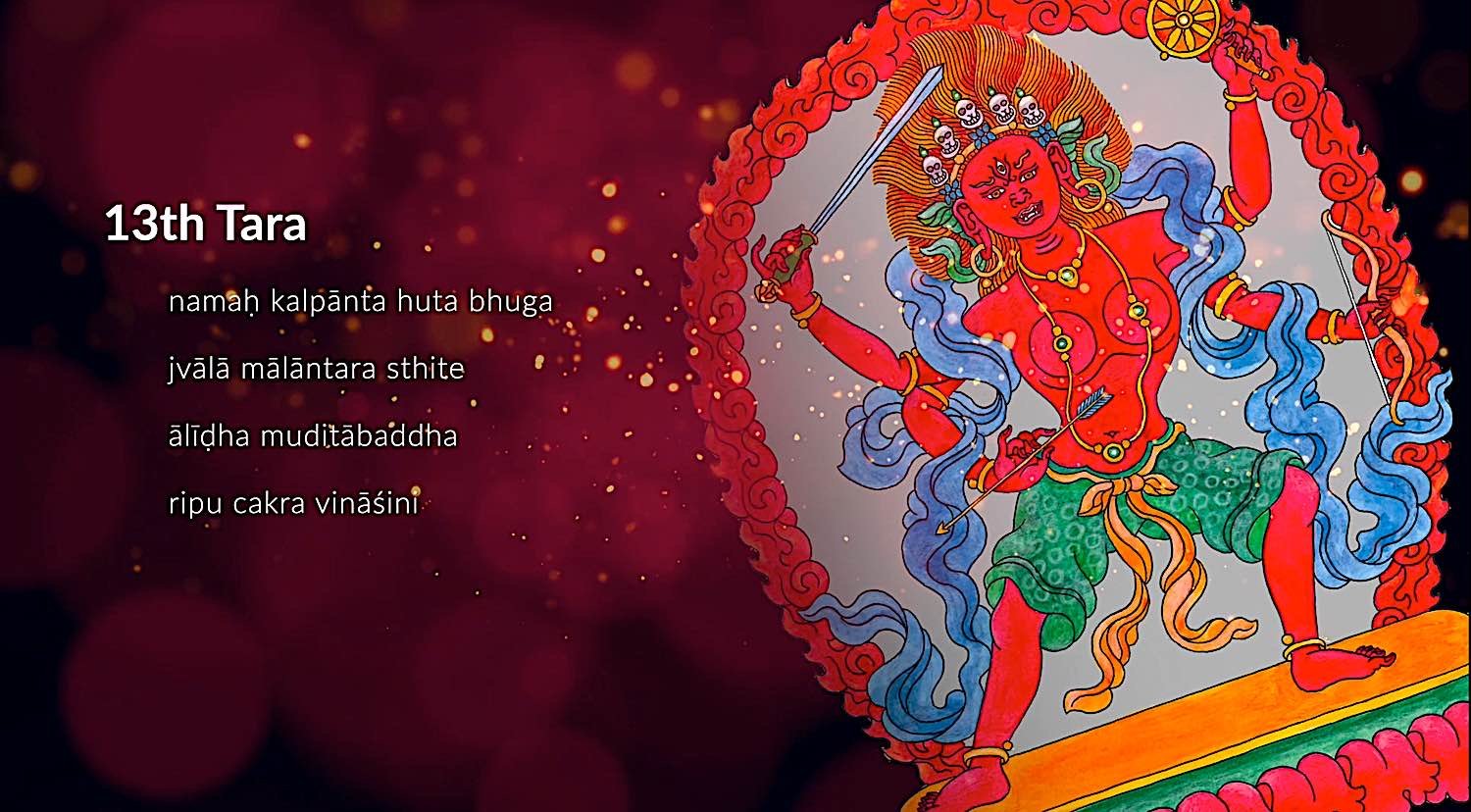
13th Tara Dharani
Sanskrit: Pari Pacaka Tara
Tibetan: Young Su Min Par Zed Pi Drolma
English: Tara the Complete Ripener
- Power or Rite: Her rite is for subduing hindrances
- Seed syllable DRUM
- Colour: red
- Number of arms: 4
- Peaceful or wrathful: wrathful
namaḥ kalpānta huta bhuga
jvālā mālāntara sthite
ālīḍha muditābaddha
ripu cakra vināśini
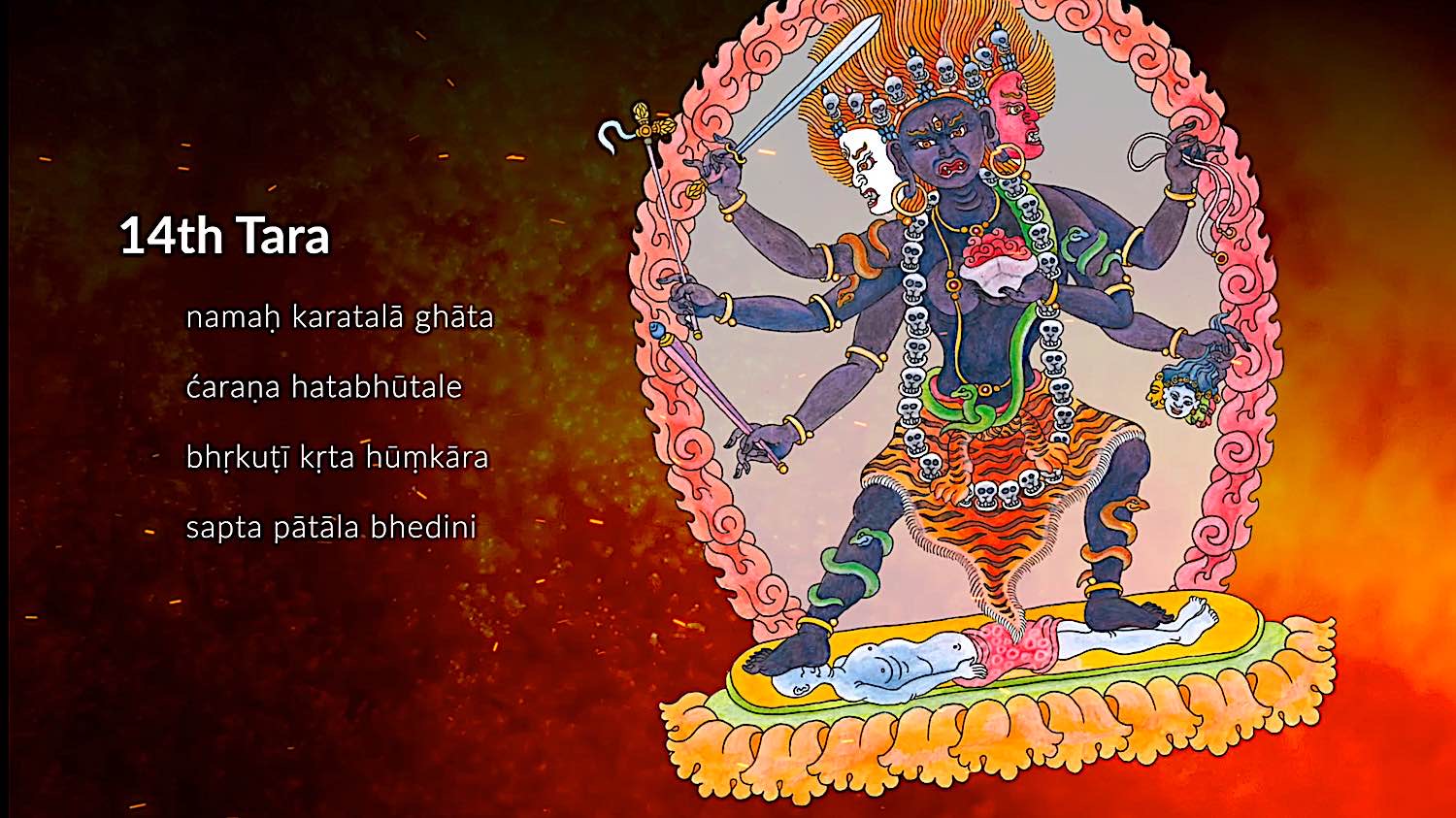
14th Tara Dharani
Sanskrit: Bhrkuti Tara
Tibetan: Tro Nyer Yo We Drolma
English: Wrathful, Shaking and Frowning Tara
- Power or Rite: Her rite is the protective circle
- Seed syllable AH TA
- Colour: black
- Number of arms: 6
- Number of faces: 3 (central black, Tara’s right white, Tara’s left red)
- Peaceful or wrathful: wrathful
namaḥ karatalā ghāta
ćaraṇa hatabhūtale
bhṛkuṭī kṛta hūṃkāra
sapta pātāla bhedini

15th Tara Dharani
Sanskrit: Maha Shanti Tara
Tibetan: She Wa Chen Mo Am Gelek Ter Wi Drolma
English: Tara the Great Peaceful One Who Provides Virtues and Goodness
- Power or Rite: cleansing, purification, praised in terms of her Dharmakaya aspect
- Seed syllable NI
- Colour: white
- Number of arms: six
- Peaceful or wrathful: peaceful
namaḥ śive śubhe śānte
śānta nirvāṇa gocare,
svāhā praṇava saṃyukte
mahā pātaka nāśini

16th Tara Dharani
Sanskrit: Raga Nisudana Tara
Tibetan: Chagpa Jom Pi Drolma
English: Tara Destroyer of All Attachment
- Power or Rite: cleansing, purification, praised in terms of her Dharmakaya aspect
- Seed syllable A (red)
- Colour: coral red
- Number of arms: two
- Peaceful or wrathful: slightly wrathful
namaḥ pramuditābaddha
ripu-gātra prabhedini
daśākṣara pada-nyāse
vidyā-hūṃkāra-dīpite
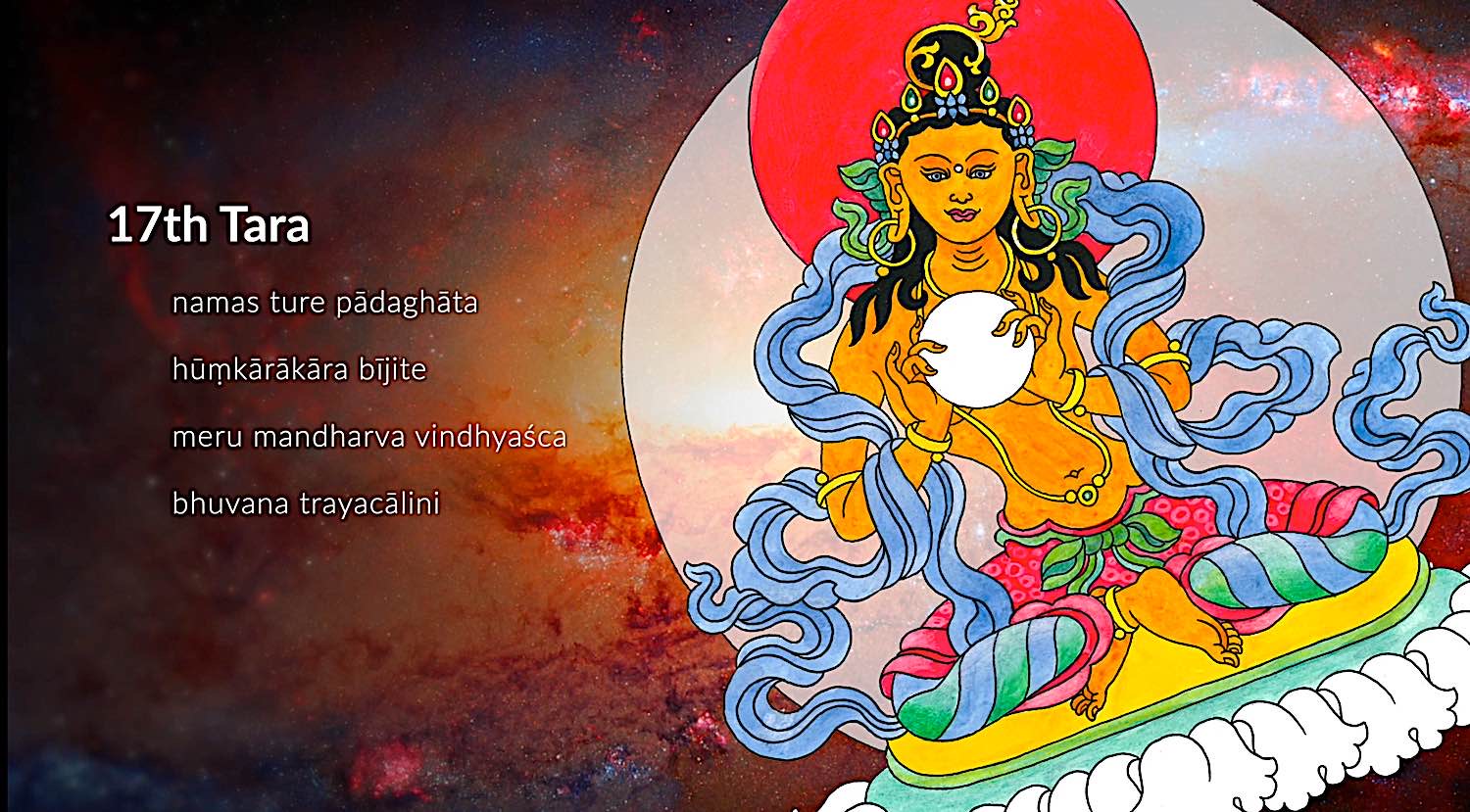
17th Tara Dharani
Sanskrit: Sukha Sadhana Tara
Tibetan:Dewa Drub Pe Drolma
English: Tara Accomplisher of Joy and Bliss
- Power or Rite: Binding thieves, praised for wrathful activity of shaking the three worlds.
- Seed syllable SHA
- Colour: orange
- Number of arms: two
- Peaceful or wrathful: peaceful
namas ture pādaghāta
hūṃkārākāra bījite
meru mandharva vindhyaśca
bhuvana trayacālini
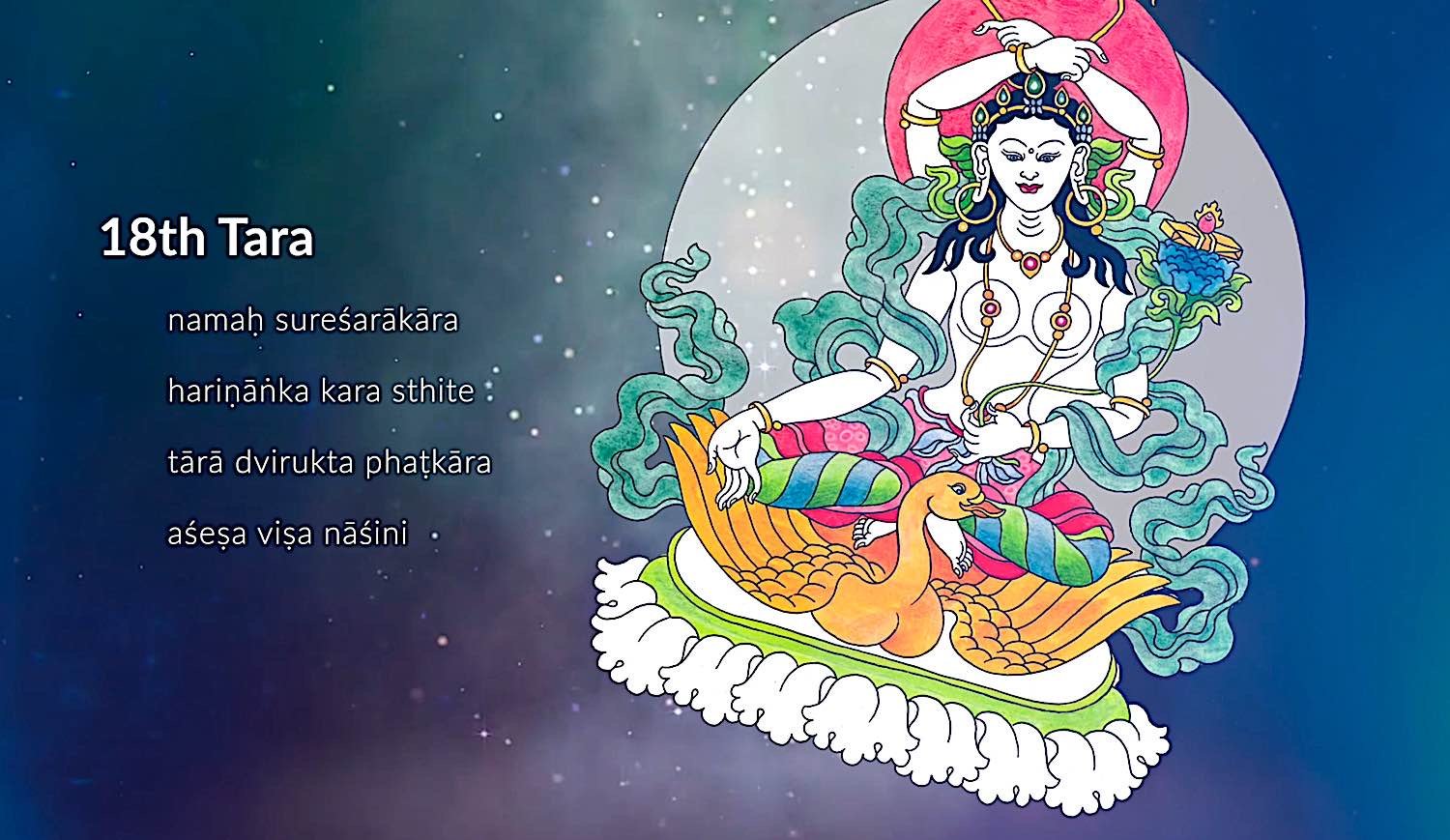
18th Tara Dharani
Sanskrit: Sita Vijaya Tara
Tibetan: Rab Tu Gye Pi Drolma
English: Victorious Tara Who Increases Realizations
- Power or Rite: Curing leprosy and Naga diseases (as Tara cured Surya Gupta.) Praised for dispelling poisons of all kinds.
- Seed syllable KE
- Colour: white
- Number of arms: four
- Peaceful or wrathful: peaceful
namaḥ sureśarākāra
hariṇāṅka kara sthite
tārā_dvirukta phaṭkāra
aśeṣa viṣa nāśini
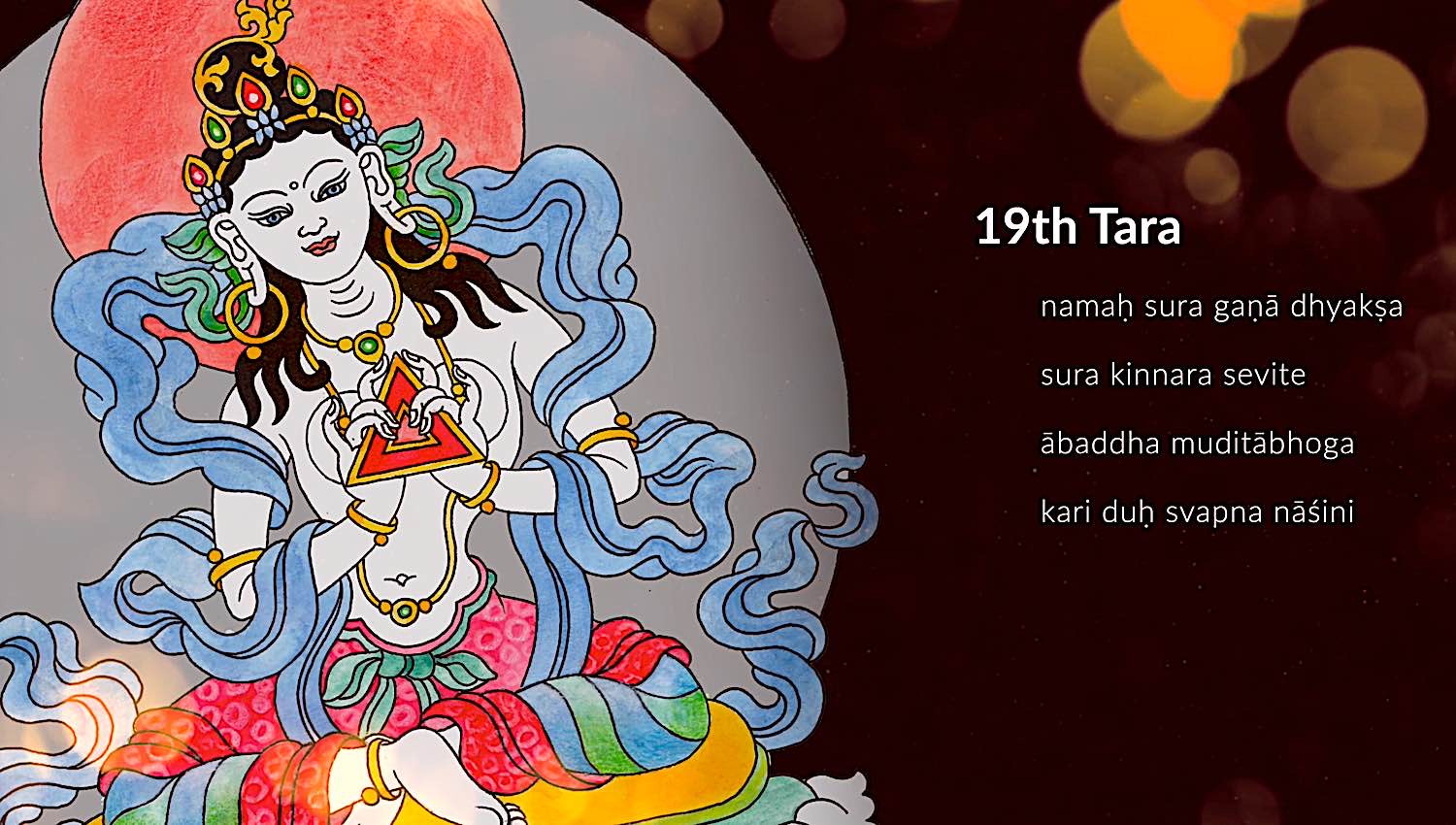
19th Tara Dharani
Sanskrit: Dukha Dahana Tara
Tibetan: Duk Ngal Sek Pi Drolma
English: Tara, Extinguisher of All Suffering
- Power or Rite: Curing leprosy and Naga diseases (as Tara cured Surya Gupta.) Praised for dispelling poisons of all kinds.
- Seed syllable ZA
- Colour: white
- Number of arms: two
- Peaceful or wrathful: peaceful
namaḥ sura gaṇā dhyakṣa
sura kinnara sevite
ābaddha muditābhoga
kari duḥ svapna nāśini

20th Tara Dharani
Sanskrit: Sidhi Sambhava Tara
Tibetan: Ngyu Drob Jung Pi Drolma
English: Tara, Source of All Powerful Attainments
- Power or Rite: Dispelling fevers and epidemics.
- Seed syllable TSE
- Colour: orange
- Number of arms: two
- Peaceful or wrathful: peaceful
namaś candrārka sampūrṇa
nayana dyuti bhāsvare
hara dvirukta tut-tāre
viṣama jvara nāśini

21st Tara Dharani
Sanskrit: Paripurana Tara
Tibetan: Yong Zog Jed Pi Drolma
English: Tara of the Perfection of Wisdom and Compassion
- Power or Rite: Rite is for “sky going” to the Akanishtha Pureland in this very life; praised for subduing evil spirits and zombies.
- Seed syllable PHE
- Colour: white
- Number of arms: two
- Peaceful or wrathful: slightly wrathful
nama stritat tvavi nyāse
śiva-śakti samanvite
graha vetāla yakṣa gaṇa
nāśini pravare ture
- Source: Tara in the Palm of Your Hand by Venerable Zasep Rinpoche, (found on Amazon here>>)
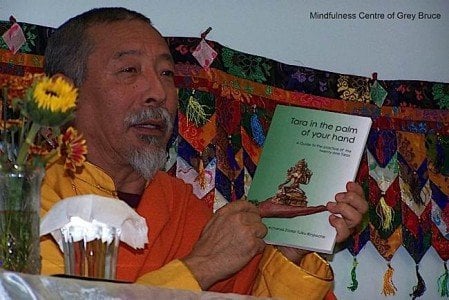
Chanting in English
Chanting the 21 Praises in English may not have the same profound vibrational intensity as the Sanskrit, but it is a popular way to honor Tara, the Mother of the Buddhas. If you prefer to chant in English, here’s our previous video version also beautifully chanted by Hrishikesh Sonar (in this version, with Surya Gupta lineage paintings by the well-known artist V.V. Sapar, used with permission):
When you do translate the praise, you can see how many of the nuances are missing. English, typically, doesn’t carry as many layered meanings. This is the English translation used in chanting:
PRAISE OF TARA’S MANTRA:
Homage to Tara the Swift and Courageous,
You drive away all our fears with TUTTARE,
Saviouress fulfilling all aims with TURE,
With syllables SVAHA, we offer homage.
21 TARAS PRAISE IN ENGLISH:
1. Heroic Red Tara
Homage to You, the Swift One, the Heroine,
Your gaze is as quick as flashes of lightning
Who arose from the majestic carolla
From the Lotus face of the Lord of Three Worlds.
2. Moonlight White Tara
Homage to You with a face that resembles
The gathering of one hundred autumn full moons
And who with the brightness of stars by the thousands
Shines in a vast perfect light of resplendence.
3. Golden Color Tara
Homage to You divine golden-blue Goddess
Whose hands are adorned by water-born lotus.
Embody Six Perfections: Giving, Patience
Ethics, Concentration, Vigor, and Wisdom
4. Golden Tara of Crown Victorious
Homage to You who crowns Buddha’s ushnishas,
Whose victorious actions have no limit.
Who has attained ev’ry transcendent wisdom,
On whom the Bodhisattvas themselves rely.
5. Tara Proclaiming the Sound of HUM
Homage to You who with HUM and TUTTARA,
Fill all worlds of desire, direction, space.
Who with your feet press down on the Seven Worlds;
You subdue all beings under your power.
6. Tara Victorious Over the Three Levels of World
Homage to You praised by Indra and Agni,
Brahma, Vayu, Ishvara and all the gods
All the spirits, zombies, and the smell-eaters,
Even the Yakshas give praise in Your presence.
7. Tara Who Crushes Adversaries
Homage to You who with the TRAY and PEY sounds,
Crush every magical wheel, evil forces,
Right leg extended and left bent, you trample,
You burn them completely in Your whirling fire.
8. Tara Who Gives Supreme Spiritual Power
Homage to You, TURE, the Boundless Fierce One,
Who totally destroys leaders of maras.
Whose lotus-like face forms furious wrinkles,
You annihilate foes without exception.
9. Tara of the Khadira Fragrant Forest
Homage to You whose fingers held at Your chest,
Displaying the mudra of the Three Jewels;
Beautiful swirling light in your precious hands
Dharma wheels connect every direction.
10. Tara Who Dispels All Suffering
Homage to You, the majestic and joyful
With brilliant garlands of light around your crown
With the great clangor of laughter TUTTARA
Over power all the worlds and the maras.
11. Tara Who Summons All Beings and Dispels Misfortune
Homage to You, endowed with the great power,
To draw assembly of worldly guardians.
The One who with the HUM of wrathful wrinkles
You rescue completely from all poverty.
12. Tara Who Grants Prosperity and Brings About Aupsiciousness
Homage to You, who is crowned with crescent moon,
And whose ornaments so brilliantly sparkle.
Amitabha in front of your ushnisha,
Eternally radiating beams of light.
13. Tara the Complete Rinpener
Homage to You, who dwell in garlands of flames
Engulfed in fire like the end of the aeon.
Right leg outstretched and left bent with blissful joy
Who with your power destroy all enemies.
14. Wrathful, Shaking and Frowning Tara
Homage to You, striking the ground with your hand
And crushing the earth with your majestic foot.
With wrathful, wrinkled face and the sound of HUM
You fully subdue seven levels of worlds.
15. Tara the Great Peaceful One Who Provides Virtues
Homage to You, happy, virtuous and peaceful,
Who acts from eternal bliss of Nirvana.
And who with the pure sounds of OM and SVAHA,
Eliminates the most unwholesome Karmas!
16. Tara Destroyer of All Attachment
Homage to You, who turns the Wheel of Dharma
For truly devoted, who love the teachings
Crushing enemies — all types of obstacles
with the Hum and the ten syllable mantra.
17. Tara Accomplisher of Joy and Bliss
Homage to You with feet stamping and Ture
Whose essence is the sacred syllable Hum.
You cause Mount Meru, Mandhara and Vindhya
Making all three worlds to tremble and shake!
18. Victorious Tara Who Increases Realizations
Homage to You, holding the moon in Your hand
Like a celestial ocean of nectar.
Sound of the PEY and the twice uttered TARA
You completely dispel every poison.
19. Tara, Extinguisher of All Suffering
Homage to You on whom the devas rely
And also the lords of all the Gandharvas.
Your armor of joy, a radiant brightness,
You eliminate arguments and nightmares.
20. Tara, Source of All Powerful Attainments
Homage to You, whose two eyes are shining bright,
Brilliant with light like the sun and the full moon.
Saying HARA twice and TUTTARE again
You clear and eliminate epidemics.
21. Tara of the Perfection of Wisdom and Compassion
Homage to You whose pure Body, Speech and Mind
Are perfect with the strength and power of peace.
Suppressing Maras, Dons, Zombies and Yakshas
With the most exalted syllable TURE.
More about Surya Gupta Lineage of 21 Taras
- The first seven Taras in the Surya Gupta lineage are more fully described in our special feature with 7 videos and 7 mantras in Sanskrit — sung by the amazing Yoko Dharma, here>>
- The second groupof seven Taras in the Surya Gupta lineage with mantra videos (part 2) is found here>>
- The final group of seven Taras in the Surya Gupta lineage with mantra videos is found here>>
- About the Nyingma and Atisha lineages of 21 Taras>>
- All about Green Tara, mother of all the Buddhas>>
- Entire section of features on Mother Tara>>
Nyingma Lineage version
Also in English, if you practice the Nyingma lineage (or Atisha, since the colors are similar — Atisha’s visualization incorporates vases instead of implements on lotuses), here’s a lovely chanted version with those visualizations, with 21 Tara Paintings by Lasha Mutual, and Green Tara image (with mantra) Jampay Dorje Ben Christian.
More articles by this author

Overcoming the Poison of Env or Irshya with Tara and her joyous Mudita, or “Sympathetic Joy”! How can joyful Tara, and other methods, help us overcome the dangerous klesha of Envy?
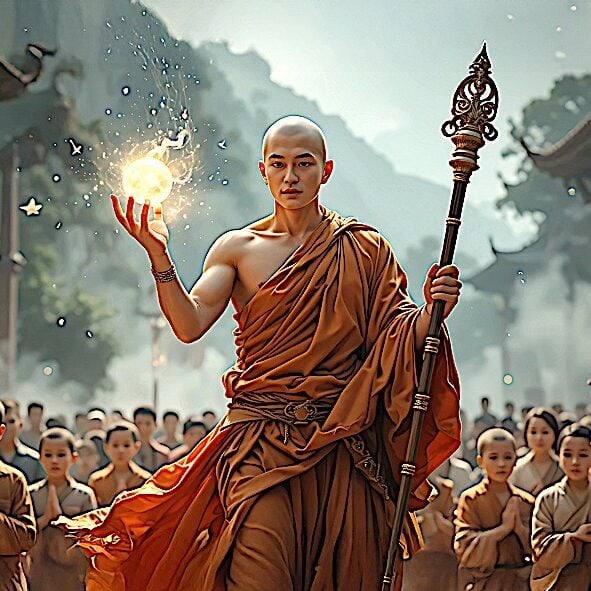
Daśacakra Kiṣitigarbha Dhāraṇī: Rescuing All Beings: The Sanskrit Dharani that Saves Beings on Hearing or Seeing or Chanting
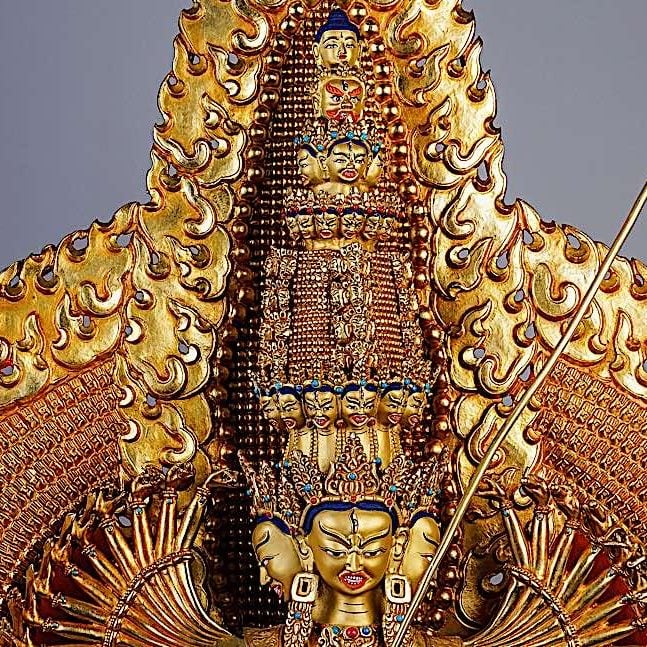
Sitatapatra or Dukkar — the ultimate protective Bodhisattva Goddess, form of Mother Tara — 1000 arms or 2 arms, she is “Aparajita” the Undefeatable One
Search
Latest Features
Please support the "Spread the Dharma" mission as one of our heroic Dharma Supporting Members, or with a one-time donation.
Please Help Support the “Spread the Dharma” Mission!
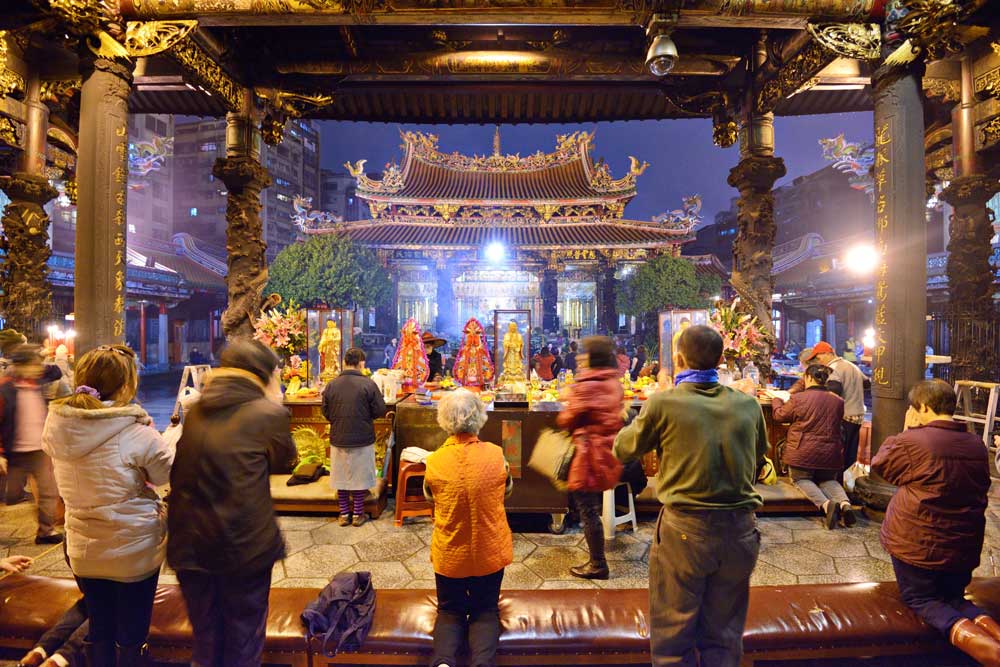
Be a part of the noble mission as a supporting member or a patron, or a volunteer contributor of content.
The power of Dharma to help sentient beings, in part, lies in ensuring access to Buddha’s precious Dharma — the mission of Buddha Weekly. We can’t do it without you!
A non-profit association since 2007, Buddha Weekly published many feature articles, videos, and, podcasts. Please consider supporting the mission to preserve and “Spread the Dharma." Your support as either a patron or a supporting member helps defray the high costs of producing quality Dharma content. Thank you! Learn more here, or become one of our super karma heroes on Patreon.
Lee Kane
Author | Buddha Weekly
Lee Kane is the editor of Buddha Weekly, since 2007. His main focuses as a writer are mindfulness techniques, meditation, Dharma and Sutra commentaries, Buddhist practices, international perspectives and traditions, Vajrayana, Mahayana, Zen. He also covers various events.
Lee also contributes as a writer to various other online magazines and blogs.

